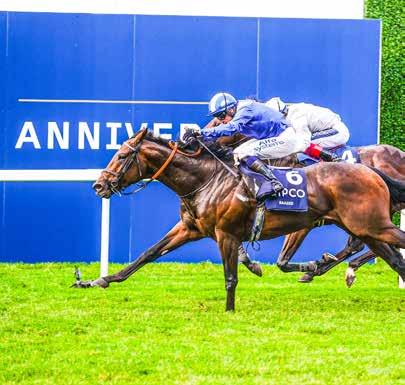

Striding forward into the yearling sales season

EURO FOCUS featuring
>> Debut Arqana August consignors Hazelwood Bloodstock & Windermere Stud
>> Ambitious owner-breeder Marian Ziburske of Westminster Race Horses
>> Ground-breaking Group 1 Deutsches Derby-winning jockey Nina Baltromei
>> Chantilly-based trainer Josephine Soudan, who is enjoying a top season
THIS MONTH’S Weatherbys Stallion Scene features Polish Vulcano and Goken
Spirit - Zenda (Zamindar)
Global appeal
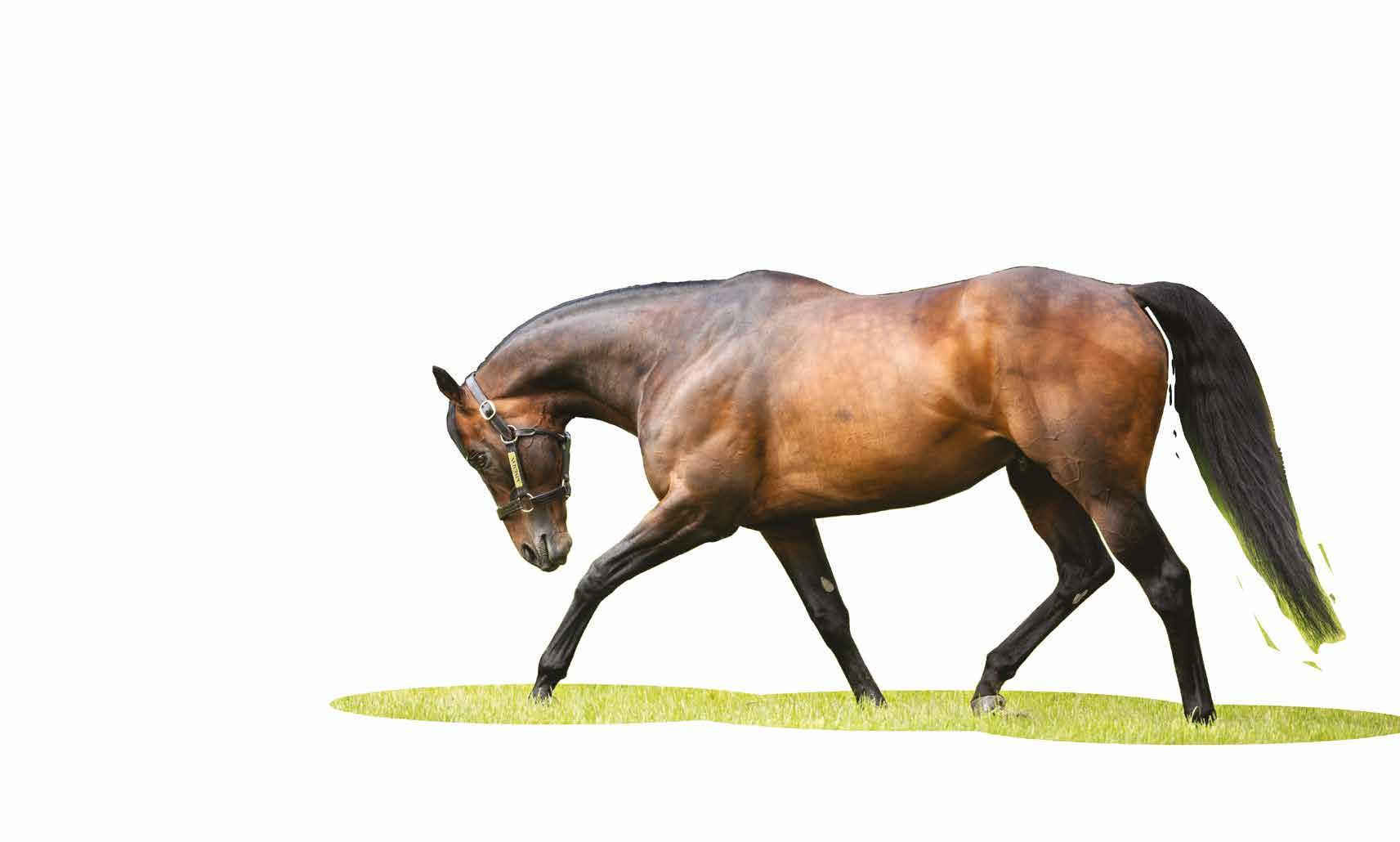
REDISTRICTING
United Nations Stakes Gr.2, 11f, Monmouth Park
QUDDWAH
Prix Messidor Gr.3, 8f, Chantilly
ENGLAND EYES
Kokura Kinen Gr.3, 10f, Kokura
Contact Ed Sackville, Shane Horan or Tom Parry +44 (0)1638 731115 | nominations@juddmonte.co.uk www.juddmonte.com




Leo
Our man enjoys getting down with the kids at the INS graduation ceremony, he recalls past champions as owner-breeders Sean and Anne Coughlan are inducted into the Hall of Fame and laments the sad loss of Jukebox Jury 15 The notable men of the ton
Top-class action on the track, record-breaking sales at Tattersalls, and three men who really had a great July week, writes Cathy Grassick
Measuring Up
The Group 1 July Cup victory of No Half Measures was a win for tenacity, longevity, and British-bred sprint breeding
The best of fun
Watching the Deutsches Derby reminded Jocelyn de Moubray of all that can be great about the sport of horseracing 28 Loss of a legend
Jill Williams pays tribute to the late D. Wayne Lukas, who changed the face of US horseracing and whose influence will be felt for years to come 32 Horses to watch
The Trackside team pick us a number of exciting and progressive horses who were selected on the company’s paddock side messaging service through July 38 Stallion statistics
Wootton Bassett builds on his early success and continues to top the European sires’ table – data courtesy of Weatherbys
42 Weatherbys Stallion Scene: 1
Explosive results: Polish Vulcano has only has 37 foals of racing age, but the son of Lomitas has bagged himself the winner of the Group 1 Deutsches Derby
45 Weatherbys Stallion Scene: 2
Cable Bay’s loss felt strongly: bloodstock agent Gaurav Rampal pays tribute to the son of Invincible Spirit whom he sourced to stand in India for the Northern Lights Stallion Syndicate
48 Weatherbys Stallion Scene: 3
Goken for glory: Haras de Colleville’s son of Kendargent is heading the current 2025 French stallions’ table by number of winners
50 High lights
Jocelyn de Moubray marks your card and picks out some of the most progressive stallions standing in France
54 Euro racing with Westminster
Ambitious owner Marian Ziburske has horses in training throughout Europe under his Westminster Race Horses banner – his goal is to win a Group 1 and sell a horse for a million euros
60 It has come together for Soudan
Chantilly-based trainer Josephine Soudan has been enjoying a top year and, despite a flat tyre on the way, had a first runner at Royal Ascot, writes Jocelyn de Moubray
64 Moving on up
Windermere Stud is selling for the first time at Arqana August, Adrien Cugnasse meets Pierre-Hugues Henry and Janine Gandy
66 A French adventure
Leading consignor Hazelwood Bloodstock is taking a debut draft to Arqana –Adrian O’Brien talks to us about the plans
70 The Dubois dispersal
Auctav is handling the dispersal of owner, trainer and breeder Jean-Pierre Dubois’ stock in a 108-lot sale
76 Breaking barriers
The Group 1 Deutsches Derby-winning jockey Nina Baltromei became the first female to ride the winner of a major European Classic, reports Catrin Nack
84 Stella summer
Stellarta: dam of the multiple Group 3 winner Rumstar and 2025’s winning juvenile and Listed-placed Amorim
86 Photo finish
Aidan O’Brien dodges Hotazhell’s hooves as the field go to post for the Eclipse Stakes




the team
editor sally duckett
publisher declan rickatson design thoroughbred publishing
advertising
declan rickatson
00 44 (0)7767 310381
declan.rickatson@btinternet.com
subscriptions tracey glaysher itsubs@btinternet.com the photographers
debbie burt
laura green goffs
alisha meeder courtesy of stud farms
marc ruhl the printers micropress press
jill
info@internationalthoroughbred.net www.internationalthoroughbred.net subscriptions: email or call as on the left, or log on to www.facebook.com/internationalthoroughbred
accounts

Leo is getting down with the kids, recalls past champions as owner-breeders Sean and Anne Coughlan are honoured and inducted into the Hall Of Fame, and he laments the loss of Jukebox Jury
The future is here
BEING IN THE PRESENCE of young people can have a number of impacts on one, especially someone in the latter stages of their sixth decade.
The well-known and much-loved racing photographer Pat Healy, as well as Goffs director and leading auctioneer Nick Nugent, use the phrase that “we are on the back nine now”.
My life experiences tell me to dismiss this thought, and embrace each and every day. My late father believed in living every day – he would wryly add, “and one day you’ll wake up dead!”
Many will look at young people today and perhaps rue wasted time, or be jealous of their youth and vibrance. I try to look at them in a very different way.
Yes, I recall what I was like at that age, and realise that today’s younger generations have more chances than we did, but also face challenges that we could never have imagined.
Recent weeks have seen graduates of many educational institutes and organisations honoured for their work and successes. In Ireland we have witnessed a number of ceremonies held to celebrate young men and women who are about to embark on new journeys into the unknown, and before them they have an array of opportunities to work, travel and develop careers in racing and bloodstock.
In recent years, I was invited by the Irish National Stud’s CEO Cathal Beale, and the farm’s head of education Anne Channon, to act as master of ceremonies for the class graduating from their worldrenowned management course.
Started more than half a century ago by the late Michael Osborne, the six-month course has been an important starting point in the careers of many of the current day leaders and influencers in the business,
In Ireland we have witnessed a number of ceremonies held to celebrate young men and women who are about to embark on new journeys into the unknown, and before them they have an array of opportunities to work, travel and develop careers in racing and bloodstock
and that is on a global scale.
There is not an area of the world where horses are bred, raced or sold that someone who completed the Irish National Stud Thoroughbred Breeding Management Course is not installed, and since its inception representatives from 36 different countries have partaken of the chance to study.
This year two new nations were represented for the first time with students from Colombia and Mexico.
It is apt that Beale was himself the star of his year at Tully, home to the Irish National Stud in Kildare, and now he oversees 20 and more students who descend on the farm each January.
This year, 24 students graduated on the eve of the Irish Derby weekend, some with distinction, and two were medal winners.
The coveted gold and silver medals were awarded to Ireland’s Luke O’Neill, and France’s Chloe de Salvador, while there were a number of individual awards, some of them appropriately presented by a member of the Irish National Stud board, Meta Osborne. As her name might suggest, she is one of three high-profile industry offspring of Michael.
During the course, different lecturers are brought in to speak to the students, myself included. I also set the class the task of writing a short essay – the best wins a cash prize, a bronze Blue Hen trophy, and get their work published in The Irish Field.
Tara Carroll was the recipient of this year’s award, though she won by a nose in a blanket finish from five or six others.
Gold medal winner Luke O’Neill is a young man about whom you will hear a great deal more, but you have to wait two more years until he is unleashed on the world. In the intervening time he will be one of the 12 Godolphin Flying Start students, and one of

three from the 2025 Irish National Stud class to make it on to that prestigious programme.
A spokesperson for his year, O’Neill also won the CEO Exam Award, set by Beale, and did so with an almost flawless score.
This achievement had Beale in awe of the student’s knowledge, though Luke has a pedigree to suggest he would do well.
He is a son of Eoghan and Melissa O’Neill, and what proud parents they were at the ceremony.
I wish someone had captured the look on Eoghan’s face when it was announced that Luke won the CEO’s prize, and the smile was even bigger – if that was possible – when it dawned that his son would be getting the highest honour.
There was an industry who’s who among the parents of the students, and plenty who did not come from a background steeped in horses.
Two of the graduates were daughters of fathers who had gone through the gates at Tully in the past.
Áine O’Rourke’s dad Garrett heads up Juddmonte in the US, while Claire Dilger’s late father Gerry was a legend in Kentucky, and in his name a number of this year’s class benefited from scholarships.
There is not an area of the world where horses are bred, raced or sold that someone who completed the Irish National Stud
Thoroughbred Breeding Management Course
is not installed
I was intrigued when I saw one member of the class from Ireland was Elle Sorensen, not an everyday Irish family name like Murphy or O’Connor. A love of ponies led Sorensen to studying equine science at the University of Limerick, and working in a range of places, from Michael Hourigan’s training yard to Hunter Valley Farm in the US, and then back in County Limerick at Peter Molony’s Rathmore Stud.
As each graduate was presented with their certificate, I tried to kill the silence with some quirky observation about the student, gleaned from their biography or something I learned about them.
When I called Sorensen to come up, I went off-piste and mentioned the un-Irishness of her name, and that my only experience of meeting someone of the same surname was half a century earlier.
Given that Wimbledon has just passed, the story appropriately involved tennis. As a reasonably able player in the days when I was a member of Mallow Lawn Tennis and Croquet Club, I was persuaded by my late mother Sheila, herself a decent junior player, to enter the Munster Championships at under-16 age group.
I headed to Limerick to play my opening game,
The class of 2025 – the Irish National Stud graduation ceremony with CEO Cathal Beale and Education Development Manager Anne Channon (centre, back row)
not expecting much, but hoping to gain from the experience.
What should have been a learning experience turned into an embarrassment. Drawn against a player called Sean Sorensen, later to become Ireland’s number one male player, I left the court with my racket practically untouched.
The humbling score line was 6-0, 6-0, and I don’t believe I even got to any of Sorensen’s serves, let alone return one!
When the graduation ceremony ended, Elle’s father Mark came up to me to reveal that Sean is his brother, and what fun he was going to have telling him the story!
Give Irish Derby day a break!
Just four weeks on from writing my last diary, in the immediate aftermath of Royal Ascot, I sat and wondered what could have happened in the meanwhile to make for interesting copy.
From a racing perspective we saw the 160th running of the Irish Derby at The Curragh, a race which attracted the first three home at Epsom.
There was little more that The Curragh executive could have done in terms of ensuring quality starters, and it is a long time since we had winners of the French and British Derbies take each other on, largely thanks to the shortening of the French Classic to 1m2f.
Well, you cannot please everyone, and some people you will never please. I was disheartened – and that is putting it mildly – to read comments on social media made by people who earn their living from race punditry, that this was an abysmal race in terms of quality.
They further bemoaned the fact that the supporting card consisted of six handicaps and two Listed races. The last pair attracted 11 and eight starters, the Irish Derby had a field of ten with three challengers from across the Irish Sea, five of the handicaps averaged 13 runners, and 25 lined up for the concluding race on the card.
The influence of the World Pool was at play, and to attract betting from overseas you need to have competitive fields.
This was achieved, and that success benefits the racecourse significantly. I read one figure that suggested to the tune of €500,000. Those who bemoan the lack of a Pattern race for juveniles on the day have a right to their view, but the two that were run the previous afternoon attracted five

...it is a long time since we had winners of the French and British Derbies take each other on largely thanks to the shortening of the French Classic to 1m2f
and six-runner fields – not in themselves betting propositions.
It is easy to knock, to criticise and to want something different. Everyone has a point of view, and one that is often overlooked is the business model for racecourses.
The Curragh has a duty to put on the best racing, to be a showcase for the sport in Ireland, but it also has to make money.
That said, perhaps racecourses, and I don’t just mean The Curragh, should make an effort to explain the challenges they face.
On a simplistic level, the man and woman on the street believes that the courses are simply lining their pockets with income from television rights.
These are substantial, have no doubt, but the work that goes on 52 weeks of a year behind the scenes could be better explained by the racecourses and their representative body.
There are two sides to every story.
Lambourn: the Epsom Derby winner coming home ahead in a competitive Irish Derby
The Coughlans honoured in the Hall Of Fame Memories of great days in the past came flooding back in the lead-up to the Irish Derby when Sean and Anne Coughlan were inducted into the Racing Legends Hall of Fame.
A small group gathered on Friday the 13th, lucky for some, to see the latest exhibition which was curated by former trainer and avid historian, Jim Kavanagh.
I was thrilled to be included, though I cannot express my feelings at the moment when Cathal Beale, wearing yet another cap, threw me a curve ball on the day and asked me to interview Sean on the spot!
Thankfully, I am not shy, and even more
Coughlan’s name is one that will also be recorded as the breeder of the great High Chaparral
and winner of a Cartier Award in 1995, she won at the highest level in four countries that year. She started her annus mirabilis with victory in the Irish 1,000 Guineas, followed up at Royal Ascot in the Coronation Stakes, and beat all-comers in the Prix du Moulin and the Breeders’ Cup Mile.
Coughlan’s name is one that will also be recorded as the breeder of the great High Chaparral.
Twice champion in the US, winner of the Derby at Epsom and the Irish equivalent at The Curragh, High Chaparral remains one of the best horses to ever come out of Ballydoyle.
The Racing Legends Hall of Fame has a temporary home in the old courthouse in Kildare town, and its existence is largely down to the tenacity and passion

A European Horse of the Year
The brilliant European champion filly Ridgewood Pearl winning the Group 1 Coronation Stakes at Royal Ascot in 1995, she was bred and owned by the Coughlans
Sad loss of Jukebox Jury
That’s life, that’s what all the people say
You’re riding high in April, shot down in May
But I know I’m gonna change that tune
When I’m back on top, back on top in June
The words of this Frank Sinatra classic came to mind in recent weeks, concerning the Connolly family at Burgage Stud in County Carlow.
The stud is owned by Victor Connolly and his wife Liz Kent, and they suffered the heartbreak of losing Jukebox Jury to complications following colic. This news came just over a week after the couple’s son George was named as the top trainee among the latest batch of Godolphin Flying Start graduates, attaining a distinction.
The loss of Jukebox Jury, though he was 19, came after the stallion enjoyed his best-ever season.
Apart
from his great ability as a top stallion, we shall all miss him terribly, as he was a kind horse with a curious and intelligent nature
Longevity seems to be par for the course with sires at Burgage Stud – think of Shantou who died at the age of 28, a year after his final year at stud. Connolly might well have dreamt of four or five more years with the horse.
What touched me about the death of Jukebox Jury was Connolly’s candidness about the emotions he felt to lose the stallion.
This is a business about making money, but it is one in which bonds between humans and horses, the depths of which cannot easily be understood by those outside the business.
Connolly’s words announcing the horse’s passing included the following: “Apart from his great ability as a top stallion, we shall all miss him terribly, as he was a kind horse, with a curious and intelligent nature.”

Victor Connolly with the late Jukebox Jury at Burgage Stud, photo taken on this year’s Irish Stallion Trail by Debbie Burt
SOURCES STARDOM of
Arqana August Sale
SIYOUNI
A ROLL OF HONOUR LIKE NO OTHER Europe’s #1 ‘Guineas’ sire
SEA THE STARS
A SIRE FOR THE AGES “responsible for true turf greats”
Don’t
miss the next generation
RISING TO THE TOP with his exceptional statistics ZARAK






...Girls aloud

FOLLOWING ON from my recent Bridgerton-themed Royal Ascot column - I briefly dabbled with the idea of changing this column from “Girls Aloud” to “Lady Whistlejacket”, which would feature an anonymous July Sale report from Newmarket full of gossip, scandal and intrigue. However, breathe a sigh of relief gentle reader, wisely I thought better of this idea, as much to protect the esteemed editor from legal proceedings as to protect any anonymous sources!
In fact, it’s a good thing that the sales and racing are of such quality as to hold the main focus of attention.
In this post-Covid world, there are now far less social occasions and events focused around the Tattersalls July Sales than there once was, and many people commented on missing the events.
One that has survived is the EBN Clay Pigeon Shoot, which sadly this year I was unable to attend. I have really enjoyed this afternoon for many years and was sad to miss out. It was however with good reason as I attended the AGM of the European Federation of Thoroughbred Breeding Associations (EFTBA) in the Jockey Club Rooms.
Sadly this is my last EFTBA meeting as that honour now passes to the new chairman of the ITBA, Cathal Beale. With so many important issues on the horizon for breeders across Europe, this was an important meeting and it was encouraging to have so many attendees from throughout Europe.
The work continues apace regarding the proposed EU Animal Welfare transport regulations, ARTVAC vaccine availability and the EFSA horse breeding data survey and we commend the tireless work of chairman Joe Hernon and veterinary officer Des Leadon.
There has been a lot done and there is a lot more to do.
The Tattersalls July Sale produced with two record-breakers. First up was Juddmonte’s filly Orchid Bouquet (Kingman) a full-sister to Calyx, who sold for 550,000gns to Badgers Bloodstock, then less than 24 hours later the Royal Ascot winner Quai De Bethune (Persian King) sold for 775,000gns to Richard Brown of Blandford Bloodstock for Wathnan Racing.
Other exciting lots included the Group 1 second Green Storm (Circus Maximus) sold to Gassim Ghazali for 380,00gns and Regal Agenda (Pinatubo) from the family of Dubai selling for 375,000gns to Ace Stud, the new name for Zhang Yuesheng’s stallion farm and formerly Dullingham Park Stud.
The July Meeting provided some wonderful racing. Godolphin enjoyed a fabulous meeting with a Group 1 Falmouth Stakes victory with Cinderella Dream (Shamardal), a Princess Of Wales’s Stakes (G2) win for El Cordobes (Frankel), Listed victory for Opera Ballo (Ghaiyyath), while the smart juvenile Saba

These “Notable men of the Ton” all enjoyed a fabulous July week (from left to right): Group 1 July Cup-winning trainer Richard Hughes, jockey William Buick, and bloodstock agent Richard Brown
Desert (Dubawi) took the Group 2 Superlative Stakes.
The biggest thrill was to see Godolphin’s stable jockey William Buick collect his 2,000th British winner on El Cordobes.
It is such a well-deserved achievement for the hard-working jockey, who was quick to credit his trainers, owners, horses and his family as being the key to his success, as he says, “Without them none of those things can happen.”
The highlight of the meeting was the July Cup (G1) victory for No Half Measures. She lived up to her name and landed the spoils under jockey Neil Callan for an emotional trainer Richard Hughes, who won the race as a jockey on Oasis Dream in 2003.
It was just beautiful to see the passion and determination of the whole team behind the Cable Bay filly in the post race celebrations, a fitting conclusion to a memorable July week. And so dearest reader it is time to sign off after another memorable July week.
This author can only watch with anticipation at what marvels these “Notable Men of the Ton” can supply us with next
“Notable men of the Ton” by Cathy Grassick, Irish Thoroughbred Breeders’ Association

Measuring UP

The Group 1 July Cup win by No Half Measures for trainer Richard Hughes, jockey Neil Callan, sire Cable Bay and joint-breeders Bumble Mitchell and Sally Nicholls was a victory for tenacity, longevity and for the British-bred sprint division
Mojo
THE GROUP 1 JULY CUP
was a victory for the older generation, for facing the challenges of life in the sport head on, the for the “oldfashioned” down-to-earth British-bred sprinting division, and a part-breeder and consignor who knows her stuff.
No Half Measures, the 66-1 chance, won the Group 1 race for Richard Hughes, a 52-year-old trainer and former top-class jockey and a man who openly talks about the challenges he has faced from alcohol and the difficulties he finds coping with the lows and the stresses that comes with training racehorses.
After the race, Hughes said: “It’s brilliant. It’s been a tough enough road to get to here. I think I’ll definitely appreciate it more than if I started with a good horse early on. I wouldn’t have appreciated it and I didn’t appreciate all those good horses when I was riding. I just keep looking for the next one and was very fortunate in my riding career.
“I was naïve when I started training –I thought you could buy 20 horses and it was going to be good. Then the following year was no good, too! You just keep chipping away, try to do the right thing.”
On when he thought No Half Measures might be special, the trainer continued: “She won a handicap here last year and when Ryan [Moore] got off her I asked will we get a bit of black-type for her?
“He said she’s better than that – Ryan never says things like that! He’s a realist. We plotted to get her back here and she has done nothing but improve.
“There was very little pressure today really. Drawn 15 I wasn’t mad about so I
said to Neil [Callan] ride her to be third and hopefully you’ll get a little bit of cover.
“At halfway, I thought she was going OK and then I just held my head as I couldn’t believe what was happening! I kept thinking she is going to get caught and I would have been pleased with second or third.”
“There were a lot of dark days when I started training but Lizzie [wife] has been a huge support to me. If dad [his late father Dessie] was here today, he’d say he helped me there.”
The July Cup-winning jockey was Neil Callan, a spritely 47-year-old whose own son Jack is now riding alongside as an apprentice. Callan Snr put his years of experience – including the nine seasons he spent in Hong Kong, where he rode 262 winners - to good use.
He has had his own professional challenges and in April 2021 was banned until the end of the Hong Kong season that July for having been disrespectful to stewards at Happy Valley. The suspension was reduced on appeal, allowing him to return to racing at the end of May.
It was his last season riding in Hong Kong; he returned to England, citing family reasons.
In the UK this March, Callan received an eight-month suspension for inappropriate use of social media, including posts that were disrespectful to British Horseracing Authority (BHA) officials or prejudicial to British horseracing. The ban was suspended for two years, which meant that he could continue to ride in races – thankfully for him in the July Cup.
Callan has ridden a career total of 14

Group 1 winners right across the globe, including Triple Time, winner of the Queen Anne Stakes in 2023 and Fonteyn, winner of the Sun Chariot Stakes, both for his former boss Kevin Ryan and owner Sheikh Mohammed Obaid.
The pair are the two previous Group 1 winners he has ridden this decade.
I was naïve when I started training – I thought you could buy 20 horses and it was going to be good. Then the following year was no good too! You just keep chipping away and try to do the right thing.
After the July Cup victory Callan said: “Last year was a bit of a struggle and this year’s been a bit of a struggle, but you just wait for that one horse.”
“It’s surreal because I’m getting into the twilight of my career. My son Jack is starting and I’m getting a lot of flak
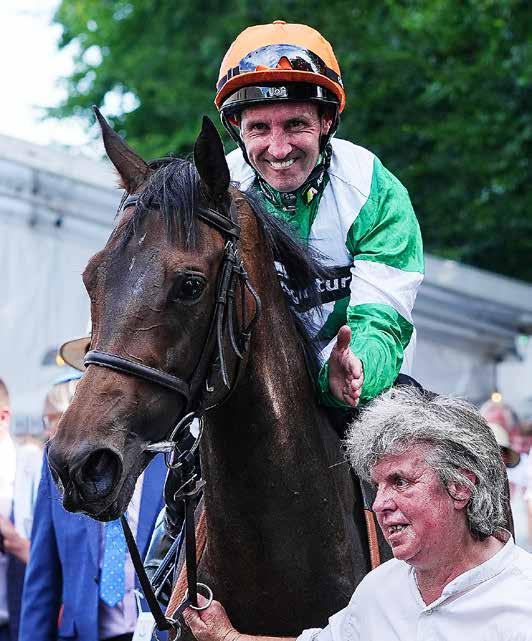
saying I’ve got to give up. He was with Kevin Ryan yesterday, my old boss, and he was telling me I’ve got to retire – so this one’s for you, Kev!”
Callan added: “You know this game - you’re only as good as your last ride so you’ve got to come out and prove yourself every time you come out, every day. This is what I tell Jack - it doesn’t matter what you’ve done yesterday, you’ve got to come out and prove yourself again.
“That’s what the best do. I’m not saying I’m the best but I’m trying to point him the way he should be going.
He’s the next generation.”
The filly’s 17-year-old sire Cable Bay, now enjoying a stud career in India (see page 46), has had something of a life of Group 1 near misses.
As a juvenile, the son of Invincible Spirit lost out by just a length and a quarter in the Group 1 Dewhurst Stakes when second to War Command.
At stud his first crop produced the capable filly Liberty Beach, who finished a two and a quarter lengths third in the King’s Stand Stakes (G1) as three-yearold behind a six-year-old Battaash and a five-year-old Equilateral
FROM CABLE BAY’S second crop came Dragon Symbol, – the Archie Watson-trained colt famously won the Group 1 Commonwealth Cup of 2021 only to have the race taken from him in the stewards’ room.
Next time out in the July Cup, Dragon Symbol put in an immense performance for a three-year-old when a length and a quarter second to this year’s first-season sire sensation Starman.
The success was something of a just result for Cable Bay, who became another northern hemisphere stallion son of Invincible Spirit to sire a Group 1 winner; the cohort headlined by this year’s all-conquering Kingman who has had 14 top-level winners and is sire of the likely 2025 champion horse of the year, Field Of Gold.
Also relocated to stand in Asia is Invincible Spirit’s son Territories, whose son Lazzat won June’s Queen Elizabeth II Jubilee Stakes after success in 2024 in the Prix de Maurice de Gheest (G1), daughter Lady Ilze, who is featured in our editorial on Westminster Race Horses (page 54), won the Group 2 German 1,000 Guineas and finished a good fifth place in the Falmouth Stakes (G1).
His son Regional took third in the King’s Stand Stakes (G1) behind American Affair and in March’s Al Quoz Sprint (G1) to Believing for Edward Bethell.
Of course, the best stallion by Invincible Spirit is the multiple Australian champion I Am Invincible, the sire of 17 southern-hemisphere Group 1 winners.
Cable Bay is also a third stallion son of the Irish National Stud former star stallion, who was retired from stud duties after the 2024 season, to sire a July Cup winner after Charm Spirit (Shaquille, 2023) and Mayson, winner of the race himself in 2012 and sire of Oxted, successful in 2020.
Oxted was also third to Starman the following year having won the Group 1 King’s Stand Stakes from
No Half Measures and Neil Callan return to the winners’ enclosure with the Group 1 July Cup on the CVs
Arecibo, also by Invincible Spirit.
Amazingly Arecibo is still racing as a 10-year-old. He has dropped to a mark of 71, but is doing a fine job of taking the apprentices around the sprint tracks in the north of England for Declan Carroll.
He has won ten races, run 87 times and was still rated 90 last year and has won prize-money of over £380,000.
NO HALF MEASURES hails from some of the best, nicest and most down-toearth breeders in the north of England, is related to one of the most popular sprinters of recent years and boast faily ties to good old-fashioned, hard-knocking British sprint pedigrees.
She was part-bred by Bumble Mitchell of Bumble Bloodstock (an online reference calls her the “legendary” Bumble Mitchell) and her neighbour Sally Nicholls of Marwell Stud.
Bumble would be one to know pedigrees and in particularly those of her Newark-based near-to-hand breeder Fiona Denniff.
So when Fascinator, a daughter of Helmet bred by Denniff, was offered to Bumble out of the Ann Duffield yard, she took the rare chance to invest in a filly from the family, not too worried about purchasing a future broodmare prospect who had run in Duffield’s name four times without success.
“Fiona Denniff has produced a brilliant family, I am a fan of Helmet mares, too, and we bought Fascinator privately,” says Bumble.
“We sent her to Cable Bay for her second covering, he’d had Liberty Beach by then. I just remember it being through the Covid year, which made everything very stressful, though on the

No Half Measures’ part-breeder Bumble Mitchell
plus side there was not much traffic on the road!”
No Half Measures is a grand-daughter of Mary Read (Bahamian Bounty), who ran seven times in her eight-race career over 5f, was BHA rated 100 and finished second in the Molecomb Stakes (G2).
Her dam Hill Welcome was bought by Denniff Farms for 3,000gns in 2001 as a three-year-old out of Barry Hills’s Faringdon Stables.
Hill Welcome did not win for her new owners and did not get a rating above 60, but the filly by Most Welcome, and despite her bargain basement price, did boast a decent sibling – she was a half-sister to the Gimcrack Stakes (G2) and Middle Park (G1) winner Stalker, who was bred and raced by Paddy
I just remember it being through the Covid year, which made everything very stressful, though on the plus side there was not much traffic on the road!
Fetherson-Godley and trained by Peter Walwyn.
Stalker finished second in the Mill Reef Stakes – after making all he was headed in the shadow of the post by Luqman.
Back in fourth place was a colt called Green Desert.
In the Middle Park Stakes, Stalker again made all, but managed to stay in front and provided a last major success for 50-year-old jockey Joe Mercer, who retired at the end of that season.
Hill Welcome and Stalker were out of a mare called Tarvie, who won three races over 6f and who was rated 101 by Timeform in 1980. She was descended from the mare Distant View.
The Denniff’s covered Hill Welcome with Bahamian Bounty and that first foal was Mary Read. She has reached the heights as a granddam of the popular but ill-fated fast-running sprinter Kachy, who, like his ancestor Stalker, jumped the stalls and liked to make all.
He won the Molecomb Stakes (G3) and finished second in the Commonwealth Cup (G1), third in the Diamond Jubilee Stakes (G1) and the Temple Stakes (G2).
Hill Welcome also became a noteworthy name in the breeding sheds thanks to her grand-son and the Denniff Farms-bred Beat The Bank (Paco Boy), twice a winner of the Summer Mile (G2), the Celebration Mile (G2), the Sandown Mile (G2), the Joel Stakes (G2) and the Thoroughbred Stakes (G3). He was also second in the Queen Anne Stakes (G1).
His half-sister Chil Chil (Exceed And Excel) won the Chipchase Stakes (G3) and took third in the Sprint Cup (G1).
And so we come full circle.
No Half Measures has an unraced two-year-old half-sister by Showcasing called Mystic Viel, owned by Fawzi Nass.
She is now in training with Archie Watson, the trainer who was denied that Group 1 victory for Dragon Symbol
And we will leave the final word to the Lincolnshire-based breeder.
“It is one of my big dreams to have bred the winner of the July Cup,” says Bumble.
Top that!
Stars of the Royal meeting, now with their first yearlings at the sales…


NAVAL CROWN PER F ECT POW ER
Dubawi’s lookalike sprinting son who won the G1 Platinum Jubilee from an elite field and beat the G1 Breeders’ Cup Mile winner... over a mile.
Winner of the G1 Commonwealth Cup and G2 Norfolk at Royal Ascot, plus the G1 Morny and G1 Middle Park. The best sprinter of his generation.


WHERE CARE SHOWS. AND STANDARDS

Breeders & Consignors know they can rely on us. For that extra bit of back up and support, Saracen are always here to help.
Partnering with

The best of FUN
Deutsches Derby: such a great race and day, writes Jocelyn de Moubray
Hochkönig (Polish Vulcano) wins the Deutsches Derby by a short head from Convergent (Fascinating Rock)

...there is never any doubt for those watching that winning the Deutsches Derby is the dream which fills the idle moments of everyone involved in German racing and breeding
THE DEUTSCHES DERBY
is always one of the most joyous events of the European racing year. Run in Hamburg at the beginning of July, the event has all the essential ingredients for a compelling sporting spectacle.
This year was a particularly special occasion and whether you were there or were one of the many, thanks to the support of the World Pool following on television, it was impossible not to smile watching the sheer joy of Hochkönig’s connections, his trainer Yasmin Almenrader, jockey Nina Baltromei and with them a large proportion of the crowd and Germany’s racing professionals.
The race always attracts a large competitive field, more often than not there are between 18 and 20 runners.
Only rarely are there short-priced favourites, champions win or are placed in the race from time to time but, in Germany, where two-year-old racing means little and most horses take time and distance to reach their peak, it is rare for the top horses to be revealed before the Derby itself.
For instance, Lando and Torquator Tasso, second to In Swoop in 2020, both started at more than 20-1.
There has been no major development of the racecourse in Hamburg for decades, there are no corporate boxes and the infield, where the paddock and the weighing room are, is filled with temporary tented bars and restaurants, and yet on Derby day and many of the other days of the meeting, there is a large enthusiastic crowd.
The race is not dominated by any one
set of connections, even if Germany’s leading trainers Andreas Wöhler and Peter Schiergen have each won five renewals.
Major breeders such as Gestüt Schlenderhan, Gestüt Ammerland, Gestüt Ittlingen, Gestüt Fahrhof, Gestüt Rottgen, Helmet von Finck, Gestüt Karslhof and Jurgen Imm have won more than once over the last 40 years, as has Darius Racing and Lars Baumgarten’s syndicate Liberty Racing, but the race has also been won by one or two horse owners such as Hochkönig’s Stall Cloverleaf.
And, whoever the winner is, there is never any doubt for those watching that winning the Deutsches Derby is the dream which fills the idle moments of everyone involved in German racing and breeding.
Not every year is the winner of the Derby a top horse, but every year it is a huge moment for all of those involved, the owner, the trainer, the breeder and the jockey; and every year their joy and excitement shines out of the television coverage.
This year’s edition was, aside from being great television, a high-class renewal.
The first six home had all shown good form beforehand and, in what was a relatively slowly run race, Hochkönig and the pair who dead-heated for fourth, Path Of Soldier and Enzian, came from a long way off the pace.
The final 400m was run in 23.1sec, or +13 per cent on the race average, and so Hochkönig showed a real turn of foot to make up the 3l or 4l he was behind Convergent at the top of the straight.
The son of Polish Vulcano, who was
Newtown Anner Stud’s son of Fascinating Rock’s confirming that the Chester Vase was this year a Group 3 with the quality of a Group 1
bred by the racecourse photographers Marc and Gabi Rühl, has looked a high-class colt since stepping up to 2200m or further.
Convergent, who had, of course, only previously been beaten by the Derby horses Lambourn and Lazy Griff, travelled well behind the leaders throughout the race and looked more or less sure to win until the final strides.
Newtown Anner Stud’s son of Fascinating Rock confirmed
turning the tables on Path Of Soldier, who had beaten him narrowly in one of the Derby trials.
Lazio, a son of Make Believe, has only disappointed when trying a slowly run French Group race.
The two, who could turn the tables on the winner in Baden-Baden, are Path Of Soldier, who would have preferred a stronger pace, and Eckhard Sauren’s Enzian, who, on only his third career start and despite being taken wide coming out of the home turn, finished
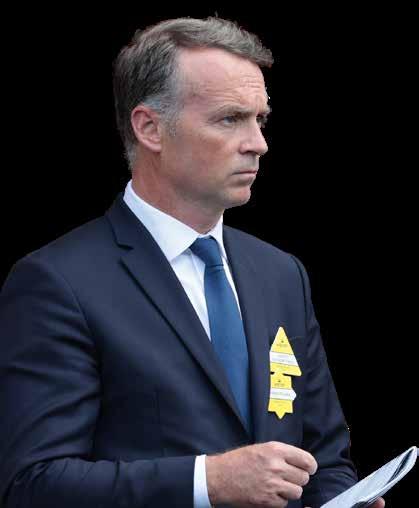
The son of Zarak had been sick after disappointing in the Union Rennen after looking like a high-class prospect when making a winning debut at Hanover.
Difficult to pick the top German
If the German three-year-old colts look to be an excellent group it is hard to pick out top-class middle-distance fillies and the Diana looks like an
The Berlin trial winner Lady Charlotte was only ninth in the Derby and Hamburg’s Diana Trial was won by the Ispahan filly Nyra, who was breaking her maiden on her sixth
Several Germantrained fillies have impressed over shorter distances, including
the Almenrader-trained 2,000 Guineas winner Matilda.
The daughter of Soldier Hollow is now with Francis-Henri Graffard and will race in the colours of Peter Brant’s White Birch Farm.
There is also the German 1,000 Guineas winner Lady Ilze, who ran respectably in the Group 1 Falmouth Stakes, and Helmut von Finck’s Soldier Hollow filly Santagada. She won her third Group race when defeating the Henri Alex Pantall-trained Idla Rossa over a mile in Hamburg.
The Schiergen-trained Santagada is entered in the Diana and, if she can stay the 2200m, she looks the most likely winner at this stage.
Soldier Hollow, who died at the beginning of the 2024 breeding season, never received the support from outside Germany that his consistent success deserved.
The son of In The Wings has only 21 three-year-olds of whom 14 have already won, and they include four black-type winners and three Group winners in Matilda, Path Of Soldier, and Santagada.
His older horses this year include Tamfana, the Group 2 winner Augustus and Egina, a dual Listed winner this year.
There are not many more to come as Soldier Hollow only has around 15 yearlings and four foals.
Graffard dominating the French racing scene
Peter Brant’s Almanzor filly Gezora became Graffard’s second Classic winner of the year in the Prix de Diane (G1), while his other runners Cankoura and Mandanaba finished third and fourth.
The stable’s other recent big race winners include Calandagan, the brilliant winner of the Group 1 Grand Prix de SaintCloud, Woodshauna, who got his head in
Francis-Henri Graffard: has had five Group 1 winners so far in 2025, and the German 2,000 Guineas winner Matilda has transferred to his yard
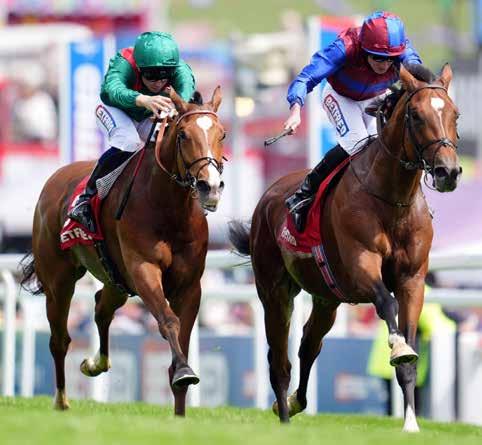
front in the final strides to win the Group 1 Prix Jean Prat, and Daryz, who remains unbeaten in four career starts and despite a very slowly run race came away from his rivals to win the Group 2 Prix Eugene Adam.
At the time of writing Graffard has won 92 races in France, 28 per cent of his runners and 28 black-type races, 37 per cent of his runners in this category.
He has already had six Group 1 wins this year with Calandagan, Gezora, Zarigana, Woodshauna and Candelari and his stable has others who could easily win a Group 1 later such as Goliath, Sunly, Daryz and others.
Over the last five years, Graffard has gone from being one of a group of younger
trainers doing well in Chantilly to be, at 48 years old, the clear leader among all trainers in France.
Graffard has the biggest string of horses, there are 225 listed on France Galop’s site, some of the most successful clients and, this year at least, almost everything he has tried has come off and the consistency of his runners has caught the attention of France’s betting public, all of his runners are well backed these days.
The Aga Khan Studs has 75 horses with Graffard, and his other major backers include Al Asayl with 20, Juddmonte with nine, White Birch Farm with seven and Resolute Bloodstock with six.
Woodshauna’s Jean Prat was a first French Group 1 win for John Stewart’s
Resolute Bloodstock – the horse was purchased at the Goffs London Sale only weeks before.
Woodshauna has been with Graffard throughout his career and now has four wins and three places from seven starts.
This year the son of Wooded has been improving with every run and, on official ratings, he has progressed 21lb since his seasonal debut on the All-Weather in Deauville in February.
Deauville’s 1400 Group 1 for three-year -olds attracted a strong international field and, like the other major races for this generation, produced a close finish with Woodshauna, Maranoa Charlie, The Lion In Winter and Shadow Of Light passing the winning post within 0.12sec of each other.
It was not a slowly run race –Woodshauna completed the final 200m only four per cent faster than his race average, and he and the fifth-placed Cacafonix both hit a top speed of 42mph – it is just that this year there seems to be a large group evenly matched three-yearolds.
Daryz is unbeaten in four starts at around 1m2f, however, the Aga Khan Studs’ son of Sea The Stars out of the Group 1 winner Daryakana, a half-brother to the Group 1 winner Dariyan, has looked like a potential top horse on his last two runs.
At the beginning of June, he won a Listed at ParisLongchamp by an easy four-and-a-half lengths and returned three weeks later to take the ridiculously slowly-run Eugene Adam from Bay City Roller.
Daryz ran the final 400m 19 per cent faster than his race average and hit a top speed of 43 mph, proving once again that the best middle-distance horses have natural speed as well as their other attributes.
Daryz will move up to Group 1 level in the future and it will be a surprise of he does not join the group of three-yearolds good enough to compete at this level, he could even be the best of all of those trained in France.
Graffard’s Calandagan finishing second in the Coronation Cup (G1) at Epsom: the Gleneagles gelding has since won Grand Prix de Saint Cloud (G1) and the King George VI and Queen Elizabeth Stakes

Loss of a legend
On June 28, US racing reverberated with the shock news of the loss of its biggest name, the brilliant trainer D Wayne Lukas, writes Jill Williams
THE SPORT WITHOUT D. WAYNE LUKAS is nearly impossible to imagine. The passing of the US racing patriarch and Hall of Fame trainer at the end of June sent shock waves throughout America. It shouldn’t have, as his family had shared a week prior to his death the
news that he had been hospitalised in Louisville with a severe infection and subsequently declined what was termed “an aggressive treatment”.
Lukas retired effective immediately and opted to go home to spend his remaining days with those closest to him. He was 89 years old.
Truth be told, if mortality really
did have to catch up with Lukas, few people in the sport thought he would die anywhere but at the track, complete with his signature spurs in place.
The icon may have been 89, but he was larger than life and seemed darn near invincible. Nearly a decade prior to his death, Lukas had a health scare while in Philadelphia for the Pennsylvania Derby.
D Wayne Lukas: transformed US racing
Nine days after surgery to insert a pacemaker and four stents, weeks earlier than doctors advised, he was back at Churchill Downs on horseback.
Tireless and driven were two of the many attributes that could be used to describe him.
We perhaps took for granted the familiar sight of him on his pony during training hours every single morning, rain or shine. The ponies changed over the years, as did his seat in the saddle – one of his few concessions to age – but he was always there, right up to the end.
His abrupt retirement, a week before his death, was inconceivable.
After reaching the pinnacle of Quarter Horse racing, conditioning just shy of two dozen champions, Lukas made the move to thoroughbreds 50 years ago and remained relevant from start to finish.
To say he shaped the game is a severe understatement.
There is a clear demarcation in American racing between the years before Lukas and the years of Lukas. He brought a will to achieve and a polish to his role that had never been seen before and has become almost standard at the elite levels since.
He pioneered the US “super-trainer” concept, establishing divisions at multiple locations throughout the country while being unafraid to ship horses to the spots they fit best, even if it happened to be 2,000 miles away.
“D. Wayne off the plane” became common vernacular.
He also didn’t hesitate to take a long-shot to a top race when nobody else would have.
“You can’t win it if you’re not in it” was one of his favorite phrases after winning with many of those same long shots.
Lukas recruited top horses and top owners, shaping the sport in ways both tangible and intangible. He sought the spotlight, yet was prickly with the media and didn’t suffer fools during his peak years. He softened his stance later in life and eventually became so approachable
There is a clear demarcation in American racing between the years before Lukas and the years of Lukas
he often plucked children out of racing crowds to join him in winners’ circle presentations.
Lukas’s career accomplishments, despite pushing the age of 40 when he transitioned to thoroughbreds, are nothing short of mind-boggling.
He focused meticulously on the Triple Crown, becoming the first trainer to saddle five horses in one year in the Grade 1 Kentucky Derby.
He won the Derby four times from his 51 starters and captured 15 Triple Crown races overall, as well as five Grade 1 Kentucky Oaks.
His career Classic wins are bookended by the Grade 1 Preakness Stakes: his first Classic victory came in the race in 1980 with Codex and his last came 44 years later when he became the oldest trainer to win a Classic when Seize the Grey

Lukas leading Optimizer (Joel Cano, aboard) after workout in preparation for the Preakness Stakes, 2012
captured the Preakness in 2024.
During the 1990s, Lukas was so dominant he won six consecutive Triple Crown events beginning with the 1994 Preakness and continuing through the 1996 Derby.
No one has exceeded his record 20 Breeders’ Cup victories.
He trained more than two dozen Eclipse Award winners and became the first trainer to surpass $100 million in earnings, as well as the first to surpass $200 million.
A member of both the Thoroughbred Hall of Fame and the Quarter Horse Hall of Fame, Lukas molded the game in ways never seen before. However, despite the accolades and the statistics, he made it clear he believed his greatest legacy was the people he mentored.
Among those who passed through his programme are fellow Hall of Famer Todd Pletcher, as well as household names such as Kiaran McLaughlin, Randy Bradshaw, Mark Hennig, George Weaver, Dallas Stewart, Mike Maker, and Sebastian ‘Bas’ Nicholl.
The latter, a former captain in the British Army and Lukas’s most recent assistant, will continue to run his barn at Churchill Downs.
The sport wasn’t the same after Lukas zeroed in on it and it won’t be the same with him gone. He will be acutely missed.
The 2025’s emerging two-year-olds
With the 2025 Triple Crown season in the books and the top three-year-olds in the land preparing for later summer targets, focus inevitably turns to the newest crop of two-year-olds.
Here again, Lukas’s impact is felt. Few could match him in the art of recruiting and developing young talent and no one could match his optimism in a two-year-old’s potential, 12 of his 20 Breeders’ Cup winners came in the two-year-old ranks.
Lukas won most of the major twoyear-old tests multiple times, with

Saratoga’s Sanford Stakes (G3) being no exception (he won it five times).
It’s the only graded race run so far in 2025 for two-year-olds in the US, and it looked to be a good one.
The Steve Asmussen trainee Obliteration did as he name suggests winning by over 10l. A Leland Ackerley Racing colour-bearer, the son of Violence is undefeated in two career starts.
But it turned out that Obliteration would have competition as America’s biggest headlining two-year-old in the first part of July.
Romeo, a son of Honor A.P. and who RNA’d for just $14,000 at the 2024 Fasig-Tipton Midlantic Fall Yearling Sale, was supplemented to the Fasig-Tipton July Horses of Racing Age Sale on the heels of setting a new track record at Churchill Downs.
Owner Mahmud Mouni went to a sale record $1.7 million to acquire him.
The sires of both Obliteration and Romeo have former Lukas stars buried deep in their pedigrees: both Storm Cat and his dam Terlingua for Violence, and that pair plus Serena’s Song for Honor A. P. It’s just another example of how deeply Lukas affected the sport.
It was a strong sales season for two-year-olds all around, with the year’s top lot being a $3 million Gun Runner colt sold at the Ocala Breeders’ March Breeze-Up Sale. However, most remarkable of all the juvenile sales this season was perhaps Fasig-Tipton’s Midlantic May Two-YearOlds in Training Sale, which overcame dreadful weather and two sales days condensed into one marathon session and set records for gross and average. Perhaps more importantly, when the last day of the under-tack portion of the sale was revised from timed breezes to open gallops and the sale still did so well, it provided an unexpected and overwhelming vote of affirmation for tossing the stopwatch.
In a move celebrated by horsemen, Fasig-Tipton responded in early July by announcing the 2026 edition of the sale will not have official clocked breezes.
Next on the 2025 agenda is the yearling sales season. Fasig-Tipton dipped a toe into the yearling market first with its one-session July Selected Yearling Sale. The sale produced steady results, but no fireworks – those yearlings are to come.
Romeo: a record €1.7 million purchase at Fasig-Tipton July after creating a track record at Churchill Downs



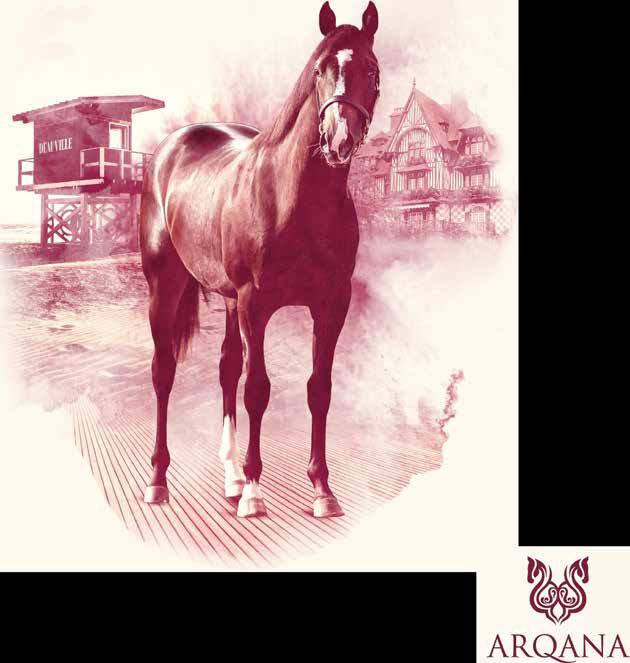
horses to follow
Horses to follow
From Royal Ascot to Newmarket’s July meeting, the Trackside team has been noting some likely improvers in its text messaging paddock-side service
Rahiebb
3yo, c, Frankel-Playful Sound (Street Cry)
Trainer: Roger Varian
Breeder: Newsells Park Stud
Owner: Sheikh Ahmed Al Maktoum
Race: June 18: Group 3 Queen’s Vase, Royal Ascot
It looked to be another useful renewal of the Queen’s Vase at this year’s Royal Ascot, a race that has been won by future
top-flight stayers such as Stradivarius (2017), Eldar Eldarov (2022) and Illinois (2024).
Whilst there was little criticism to be levelled at the impressive winner Carmers, it was the third-placed Rahiebb who caught the eye as a possible horse to follow for the future.
Trained by Roger Varian, the deep-


Rahiebb: before finishing third in the Queen’s Vase at Royal Ascot
chested, burly colt had all the physical attributes of an eye-catcher but jogged and pulled throughout the preliminaries, leaving the paddock for the start in a heavy sweat.
His progressive headway at the 2f marker to dispute second marked him out as a colt to watch going forward and breeding suggests that a return to middle-distances may prove key.
The son of Frankel is out of the four-time-winning mare Playful Sound (Street Cry), who was seen to her best effect over 1m2f but has already produced
horses to follow
It would be fair to imagine we might see a more professional version of Catullus next time and he has a smart enough pedigree to envisage that he can make an impact in at least minor black-type company
a 7f juvenile winner.
Rahiebb holds an early entry in the Great Voltigeur Stakes (G2) over 1m4f at the York meeting.
Publish (in the Juddmonte colours) finishing second in a maiden at Sandown’s Eclipse meeting: the colt is out of a US Grade 2-winning mare purchased by Juddmonte in 2021

Publish (Update... won on July 24) 2yo c, Kingman-Nay Lady Nay (No Nay Never)
Trainer: John and Thady Gosden
Breeder: Juddmonte Farms Ltd
Owner: Juddmonte
Race: July4, Tattersalls EBF Novice, Sandown There was plenty of discussion regarding the ride of Colin Keane aboard debutante Publish in the Tattersalls EBF Novice Stakes at Sandown, with the colt struggling to find a clear run before making eye-catching progress to finish second behind Pacifica Pier.
He is a big, raw colt with plenty of maturing and filling out to do and anything that was achieved at Sandown should be bettered later in the season.
He boasts an interesting pedigree –his dam Nay Lady Nay was a broodmare purchase by Juddmonte for $1,700,000 at the Fasig-Tipton November Sale from Hidden Brook.
She was a winner on Turf at Grade 2 level at Churchill Downs over a mile when trained by Chad Brown, and is a full-sister to Aidan O’Brien’s high-class juvenile Arizona, who won the Group 2 Coventry Stakes at Royal Ascot.
It is also the family of the Italian 1m1f two-year-old Group 3 winner Fathayer and the Prix Jean-Luc Lagardère (G1) and Prix Morny (G1) winner Dabirsim.
Catullus (Update... second to Publish on July 24)
2yo, c, Invincible Spirit-Communicate (Dubawi)
Trainer: Charlie Appleby
Breeder: Godolphin
Owner: Godolphin
Race: July 11, Weatherbys British EBF Maiden, Newmarket
In a 12-runner colts and gelding maiden,
horses to follow
there is always going to be a horse who catches the eye with green behaviour in the preliminaries – Charlie Appleby’s Catullus came into the pre-parade with plenty of fanfare, shouting throughout and greeting all newcomers as they arrived.
Despite his obvious inexperience, the son of Invincible Spirit produced an eye-catching run to finish best of the rest behind Distant Storm and Constitution River – making considerable headway in the closing stages despite hanging left with a furlong to run. It would be fair to imagine we might see a more professional version of Catullus next time and he has a smartenough pedigree to envisage that he can make an impact in at least minor black-type company.
His dam Communicate (Dubawi) is out of the Group 3 Sweet Solera Stakes winner Discourse, who produced three
individual black-type performers, and is a half-sister to Bandini (Fusaichi Pegasus), winner of the 1m1f Blue Grass Stakes (G1).
Venetian Prince 2yo, c, St Mark’s BasilicaArabian Queen (Dubawi)
Trainer: Andrew Balding
Breeder: Littleton Stud
Owner: J C Smith
Race: July 11, Weatherbys British EBF Maiden (Colts & Geldings), Newmarket
It seems a bit of a cheat to put in a second horse-to-follow from the same Weatherbys-sponsored 7f colts and geldings maiden at Newmarket’s July Festival, but it is a race that tends to throw up future winners – in 2024 the contest was taken in emphatic style by this year’s star Field Of Gold.
Venetian Prince is the sixth foal out of Jeff Smith’s great Group 1-winning mare

Arabian Queen, best remembered for her defeat of Golden Horn in the Juddmonte International (G1), and he is another carbon copy of his siblings.
From a paddock perspective, Arabian Queen’s offspring – think See The Fire, Royal Playwright, Spirit Mixer – tend to earn the tag “always present well”.
They’re a good-looking bunch and Venetian Prince fits into the same mould, as a smart, compact chestnut colt.
He ran commendably for a debut effort to finish sixth in a hot race and looks likely to produce a juvenile success before the end of the season.
New Vega (Update...wonAugust2)
2yo, f, New Bay-Envega (Lope De Vega)
Trainer: Simon & Ed Crisford
Breeder: Montcastle Bloodstock Ltd
Owner: Sky Racing Club
Race: July 12, Rossdales British EBF Maiden Fillies’, Newmarket
Professionalism was the name of the game in the Rossdales British EBF Maiden Fillies’ Stakes and the previous experience of Orion’s Belt played to her strengths as she took a comfortable victory.
It was the second-placed New Vega who caught the eye on her racecourse debut, having been bought for €450,000 at the Arqana May Breeze-Up Sale by Alessandro Marconi, and is now in Sky Racing Club ownership.
It was a considerable upgrade on her £50,000 price tag at Goffs Premier Yearling Sale when purchased by her two-year-old consignor Johnny Collins’ Brown Island Stables.
She was relatively professional for a debutante and you could see why she appealed at the breeze-up sales, a well-balanced two-year-old ready to race but with the scope to train on as an older filly.
The daughter of New Bay was prominent and kept on well for second, indicating that a good win would be well within her capabilities going forward.
New Vega: the Arqana May breeze-up filly by New Bay in the parade ring for her debut at Newmarket


COME and VISIT our consignment at the Arqana August Sale
51yearlings
By the best sires in Europe: Dark Angel, Kingman (2), Kodiac (2), Night Of Thunder (2), Siyouni, Wootton Bassett (3), Zarak (2)...
Latest news
with our 2YOS ...
PISTOIA
Debut winner at 2YO at Saint-Cloud in July






Debut winner at 2YO in July
CAPE ASHIZURI




Maiden 2YO winner
Chantilly in June
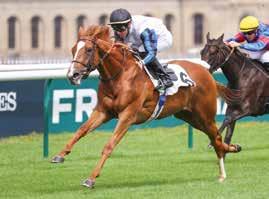

ARKANSAS winner at 2YO
Chantilly in July
BANDIAGARA
© Agence G / Scoopdyga & Zuzanna Lupa
Leading European Sires 2025 (by prize-money earned to July 21, 2025)
Courtesy of Weatherbys
A RICH HISTORY OF SUCCESS
Recent BALLYLINCH GRADUATES include: CARL SPACKLER
BLUE BOLT
· Distaff Stakes LR in 2025
CARL SPACKLER
· Maker's Mark Mile Stakes Gr.1 in 2025
· Coolmore Turf Mile Stakes Gr.1 in 2024
· Fourstardave Handicap Gr.1 in 2024
· Hall Of Fame Stakes Gr.2
· Kelso Stakes Gr.3 in 2024
· Saranac Stakes Gr.3
CARMERS
· Queen's Vase Gr.2 at Royal Ascot in 2025
CATALINA DELCARPIO
· 2nd Salsabil Stakes Gr.3 in 2025
· 3rd Ribblesdale Stakes Gr.2 at Royal Ascot in 2025
FIVE TOWNS
· Dahlia Stakes LR in 2024
· 2nd Sand Springs Stakes LR in 2025
· 3rd Canadian Stakes Gr.2 in 2024
FURTHUR
· 2nd Queen's Vase, Gr.2 at Royal Ascot in 2025
GRAND STARS
· Prix Solitude LR in 2024
· 2nd La Coupe Gr.3 in 2025
· 3rd Prix Corrida Gr.2 in 2025
KING'S GAMBLE
· 2nd Hackwood Stakes Gr.3 in 2025
· 2nd Thoroughbred Stakes Gr.3 in 2024
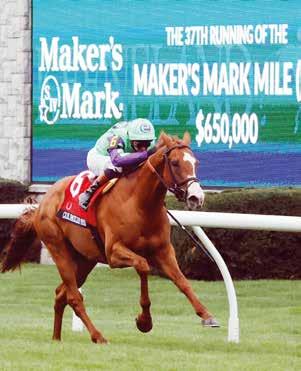
Triple Gr.1 Winner

· 3rd Gimcrack Stakes Gr.2 in 2023
MISS INFORMATION
· Kensington Palace Stakes at Royal Ascot in 2025
NOBLE CHAMPION
· Jersey Stakes Gr.3 at Royal Ascot in 2025
SCORTHY CHAMP
· National Stakes Gr.1 in 2024
SPIRITUAL
SCORTHY CHAMP Gr.1 Winner

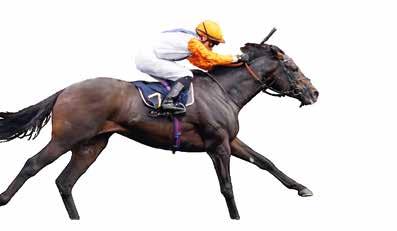
NOBLE CHAMPION Gr.3 Winner
· Princess Elizabeth Stakes Gr.3 in 2025

SPIRITUAL Gr.3 Winner
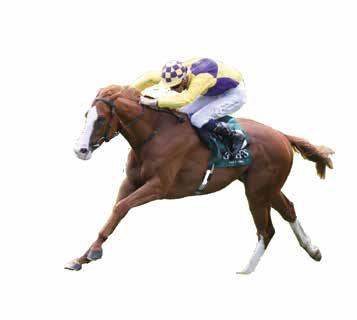

CARMERS Gr.2 Winner
DON’T MISS our yearling consignments at & ,



















































Explosive results
From just 37 living foals of racing age, Polish Vulcano has produced this year’s Group 1 Deutsches Derby winner Hochkönig and the two-time Group 3 winner Sir Polski.
He is by Lomitas, who produced such a high number of top-class horses from his German crops.
We catch up with the Derby-winning breeders Marc and Gabi Rühl, and hear what led them to use the Gestüt Idee-based Polish Vulcano –Rühl’s day job as a professional racing and bloodstock photographer playing a significant part in the selection process


Photography courtesy of Marc Rühl
Use this QR code to listen to Marc and Gabi Rűhl in the Weatherbys-sponsored bloodstock section of the Nick Luck Podcast


THE FIRST TWO HOME IN THE DEUTSCHES DERBY, produced a result perhaps unexpected by the wider European racing world but it was a race run true to form – the winner Hochkönig had previously finished second in the Group 2 Union Rennen, the major trial in Germany for the Derby, while the second-placed Karl Burke-trained Convergent had collected third place in the Group 3 Chester Vase, a race that is looking now as though it was the most important trial ahead of this year’s European Classic season –the winner of the race being Lambourn and the runner-up the two-time Derby-placed Lazy Griff.
Neither the first nor the second in the Deutsches Derby is by what would be termed a commercial Flat sire –Hochkönig is by the German sire Polish Vulcano whose book has been under ten mares for the last couple of seasons, while Convergent is a son of Fascinating Rock now standing as a jumps sire at Burgage Stud. It is a remarkable achievement by both sires.
Polish Vulcano, a son of the underrated sire Lomitas, was homebred by Gestüt Idee, where the 17-year-old now stands.
He was born in 2008, and was conceived the first year of Lomitas’ return to Gestüt Fährhof from a five-year stint at Dalham Hall Stud, Newmarket where he stood under the Darley banner.
By Niniski, Lomitas was a runner-up in the 1991 Deutsches Derby before going on to victory in the Grosser Preis der Berliner (G1), Grosser Preis von Baden (G1) and the Geno Europa Preis (G1).
In his first crop, three-year-olds of 1999, he produced Belenus, who won the Deutsches Derby for trainer Andreas Wöhler, finishing ahead of paternal sibling and fourth-placed Silvano, who had won the Union Rennen and was also with Wöhler.
Belenus went on to further German Group 1 success, while Silvano headed on
his travels in 2001 to win the Arlington Million and the Queen Elizabeth II Cup at Sha Tin.
That same crop also produced Sumitas, a Group 3-winning two-year-old and victorious in the Mehl-Mülhens-Rennen (G2) as a three-year-old.
He was also three-times placed in Group 1 races later that year and again as a four-year-old with a best result coming when second to Dubai Millenium in the millennial-running of the Prince of Wales’s Stakes (G1).
Lomitas’ second crop born in 1997 saw the arrival of the
and achieved a Listed win and a placed result in his four-year-old career, but did not run then until the July of his five-year-old season when he collected a further Listed placing before success in August at Group 3 level over 1m2f.
He went on to finish minor placed in Group races with a best result coming as a six-year-old in the 2014 Group 1 Grosser Dallmayr Preis when fifth.
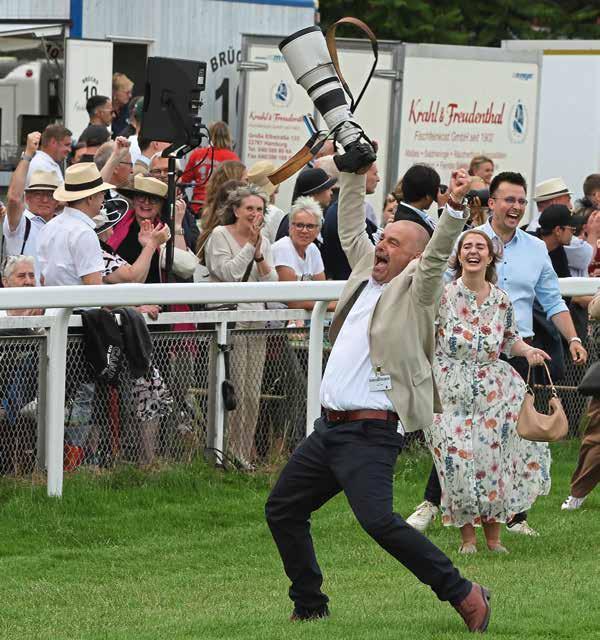
Hochkönig’s breeder and racecourse photographer Marc Rűhl realising that he and his wife Gabi have bred the winner of the Deutsches Derby

Retired to breeder Albert Darboven’s Gestüt Idee, he has since had six crops of racing age, just 37 living foals of racing age, and has five two-year-olds, six yearlings and five foals on the ground.
AMAZINGLY, that tiny cohort has produced July’s Deutsches Derby winner, who was bred by the racecourse photographers Marc and Gabi Rühl under the couple’s breeding banner of Stall MarcRuehl.com, as well as a dual winner of the Italian St Leger, Sir Polski.
Hochkönig is out of the winning Kallisto mare Halinara, bred by Rühl.
She is out of The Minstrel mare Habina, the dam of five multiple winners in Germany, and bought by the Rühls from Gestüt Schlenderhand with the hopedfor ambition, as for all of those breeding thoroughbreds in Germany, of producing a Deutsches Derby winner.
The couple explain their thinking behind using Polish Vulcano to try and achieve that Classic goal.
“There are not many stallions [in Germany] who have a better race record than Polish Vulcano,” says Marc Rühl
“He has a good pedigree, he has a good physique and is a nice stallion.
“We wanted the cross because Habina, the grandmother of Hochkönig, is by The Minstrel. We thought it would be a good cross. Halinara ran over 2,000m and we thought that maybe she could get a bit
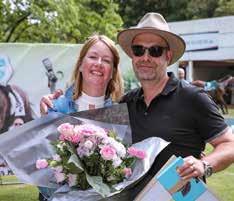
of the Lando mare Sweet Montana once owned by the Rühls.
“The stallion was on our radar because we had owned the dam of Sir Polski before and we were very happy that she got such a good home at Mr Darboven’s stud. We saw her at the farm and she had a nice foal and yearling so he was on our list,” they explain.
The 17-year-old Polish Vulcano is quite likely to see his patronage increase after this Classic victory – and obviously Halinara will be at the top of his list of mares to visit next spring.
She is to be joined by her first foal and Rühl-owned Halima, who is by Tertullian and won as a four-year-old.
The Rühls have bred “five or six black-type horses” from just a handful of mares, yet another incredible German bloodstock success story.
They credit this to the love and hands-on care they give to their horses, while stallion selection is made according to budget and to their own opinion, they do not follow the ebbs and flows of stallion fashion.
“We don’t use expensive stallions, we have to use the ones that are possible for us,” says Rühl. “And the most important thing is the mare, you need a good mare and then you have to look at what is good for her and what is possible.”
As his wife adds, “For us it is not important to go to a stallion who is in fashion. Our focus is on breeding a good racehorse.”
Rühl also attributes the influence from his job as a photographer which involves work on the racecourse, but also for Darley and other farms taking publicity shots of the stallions.
“When I am doing the stallion pictures, I know how the horse behaves so that helps us with stallion selection.”
further, but still needed pace.”
It was not the first time that the couple have had connection with Polish Vulcano – his other black-type winner (remember from that incredibly small batch of 37!) is the Gestüt Idee-bred Sir Polski – he is out
So the wheel has turned full circle –Polish Vulcano, a son of the former Darley stallion Lomitas and who finished second in the Deutsches Derby, has produced his own Deutsches Derby winner bred by the man who now takes photos of Darley stallions.
The Derby winner at the Rühl’s farm with Halinara – she returns to Polish Vulcano next spring
Gabi and Marc Rühl: winning breeders

Cable’s loss felt strongly
Gaurav Rampal, who sourced Cable Bay for the Northern Lights Stallion Syndicate in India, chatted to us about the son of Invincible Spirit after his first European Group 1 progeny victory came courtesy of No Half Measures’ July Cup win – less than a month later Rampal spoke to us again after the sire’s sad passing.
Note: that first version of this story was written after the July Cup, but was updated in the Issuu PDF and on the web story after Cable Bay’s death was announced. The first version is in the printed magazine.
LIFE is so fragile. It is something that, as horse and bloodstock people we fully understand, but why, when a loss does take place, does it always seem to happen just when things are set for progress?
Less than a month after No Half Measures’ 66-1 victory in the Group 1 July Cup, a ground-breaking victory for so many involved with the filly, including her trainer, jockey, part-breeder, and her stallion’s stud farm connections in India, it was announced by the Punjab-based Northern Lights Syndicate that her sire Cable Bay, who had been resident in India for three years, had passed away.
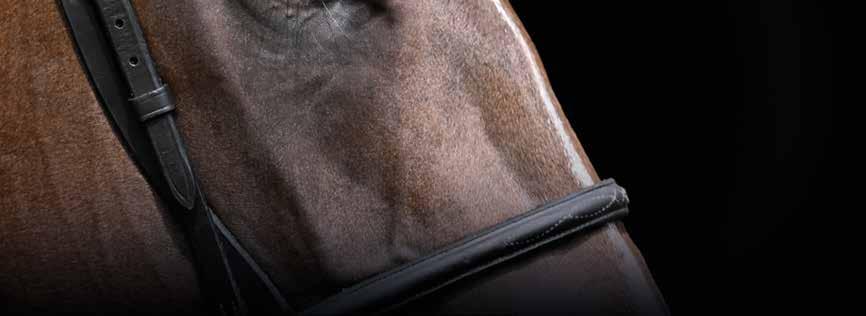

The filly’s July course top-level sprint success was the first European Group 1 winner for the son of Invincible Spirit, a moment of magic for the sire and a victory that boded a future full of promise for his Indian connections.
Bloodstock agent Gaurav Rampal, who brokered the stallion’s transfer deal from Highclere Stud, where the Group 2-winning and Dewhurst Stakes (G1) runner-up had stood from 2016 to 2022, is understandably devastated by the sad news.
“Cable Bay’s loss is such a shame for
the syndicate, and it is a big loss for India,” rues Rampal.
“He has had two Group 1 winners since his move to India – Uncommon James was his first, he won a Group 1 in Australia in February 2023 and has continued to run with credit at the highest level. He and No Half Measures

have shown the ability that Cable Bay could impart to his stock.
“Cable Bay does have the crops on the ground and, hopefully, those horses will go on to vindicate the decision by the syndicate to stand him in India.”
The bereft Northern Lights Stallion
Cable Bay: news came through of his death at the beginning of August
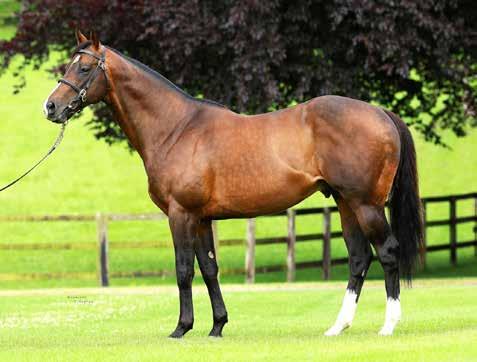

Gaurav Rampal: combines bloodstock agency work with business training
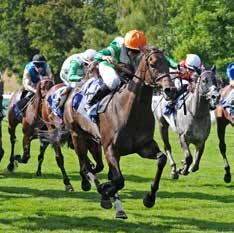
Syndicate is made up of a group of four farms, all in the Punjab region. When all decided they wanted better access to improved sire power, they decided that together they would be stronger; it makes the death of Cable Bay a fourfold loss.
“They are relatively small-scale farms, with broodmare bands of around 15 to 20 each,” explains Rampal. “India doesn’t have stallion stations as such, mares don’t walk in, and there are very few farms which share stallions or nominations, it is all very restricted and makes this such a big loss for the group.”
When he purchased Cable Bay, Rampal didn’t have “an exclusive mandate”, but when he heard that the son of Invincible Spirit might be on the market, he believed that the stallion might well be one to suit the syndicate and the Indian bloodstock industry, which is looking to develop its speed bias.
“Cable Bay’s own racing form looked very attractive, and he obviously got sprinters and these guys are primarily positioning themselves to be sprintingoriented farms. He had also produced some useful horses such as Liberty Beach and Dragon Symbol.”
Despite having those two smart
stakes sprint performers in his early crops, Cable Bay was falling short of the required level to be a commercial success in Europe.
“It is just a tough business, a stallion can be fashionable today, but not six months down the line,” reasons Rampal.
“And for those other big farms in Britain and Ireland with many stallions on a roster it is much easier – a breeder may give the nominations team a call and an outline price point, those farms can then offer five or six stallions for the breeder to choose from.”
But while Cable Bay was struggling to find a market position in the UK, for the syndicate buyers in India his purchase was an important and upgraded investment.
“It was definitely a big step up and a big decision for the group,” says Rampal, who goes on to recall an amusing story regarding the purchase.
“The guys had a lot of fun – once the deal was done, we did not immediately disclose the detail of the buyer, and word got out that the horse had been bought for one of the big farms in India.
strike at the worst of times, there is always a great capacity for a renewal of life and a positive view to the future.
In this industry with young racehorses there is always hope of a champion emerging, let’s hope Cable Bay’s all-too-brief stint in India will be remembered on racecourses and in pedigrees through the years to come.
The Horseman Way
The one-man band Rampal is far from a one-trick pony and he has made full use of his degree and business training – he has taught business for some years and describes his life as “making a living from two passions” finding that a non-bloodstock role is an essential way for him to retain perspective on life.
“I always want to be in touch with what’s happening with younger people as well as in the corporates, so for a long time I have been involved in the education space at business school level,” he says.
“This has kept me quite in-sync with what’s happening outside the equine world – living in the bloodstock bubble alone can be a dangerous one!”
Some people come into your life for a reason, and some come for a season, so you have got to treat them accordingly
“The Northern Lights guys stayed quiet for a while and enjoyed the whole conversation around the purchase,
“I think they liked the fact that rumours implied that a big farm had bought Cable Bay. It kind of validated their decision, people saying that the sire was a suitable prospect to stand at a large farm.”
Hopefully, the European stallionbuying experience was a good one for the syndicate, and they will be back in the future.
While disaster and death do always
Over the last two years, beginning in India and now moving to the UK working with Eileen Harte of Keith Harte Bloodstock, he has developed his own business training programme bringing those two passions of his life into one.
It is called The Horseman Way and he uses (real) horses in outside workshops to help corporate leaders and senior managers develop a more empathic way to do business.
“I realised that you can learn so much from horses, so I started putting a concept and a plan together,” he explains of his unique and groundbreaking project.
“I started educating myself a lot in
Cable Bay’s Group 1 winner No Half Measures

psychology and neuroscience, it has taken me almost 10 years to develop the training to where it has reached right now, it has been out in India for two years and we already have 170 graduates.”
It is a far-reaching concept and he explains further.
“We conduct empathy-driven coaching with a special focus on emotional intelligence, and we use horses as a medium,” he outlines, going on to add: “There are four pillars to the programme. The first one is biomimicry, which takes inspiration from nature to solve human challenges. And in this case, we take nature from horses to solve emotional intelligence.
“The second is kinesthetics. We use sensory perceptions of muscles, the logic being that your body never lies. Your body knows your truth and what you’re feeling – there’s a reason why it’s called ‘gut feeling’.
“Third is human psychology, while the fourth is this neurobiological miracle we work with.
“The horse is a prey animal and is hardwired to run for survival. Humans
Our relationship with the horse is the only combination of a prey and a predator which shares a trusted bond
are predators, we are hardwired to hunt for survival.
“Our relationship with the horse is the only combination of a prey and a predator which shares a trusted bond, and this trusted bond has been working together for thousands of years.
“Because of this, the horse has a sharp, correct, acute understanding of human presence and energy.
“So, in my programme, the horse works as a mirror. We as horse people know that if we are scared, the horse is scared. If we are confident, the horse is confident. If we are indecisive and confused, then the horse is indecisive and confused, too.
“The horse reflects our true personality, one beyond the mask and the armour that we carry; it knows your true presence – and the workshop revolves around helping people recognise their true selves.”
Rampal quotes a recent risk report from the World Economic Forum stating that a decline in human empathy has been recognised as a global risk.
Rampal’s workshops aim to deal with this head on using the human-equine interactions as a way for business people to be more in touch with emotions.
“Developing a listening-led, empathetic-leadership is what the programme is all about and the horses are our tool to learn these skills,” he says. “We sit people in an outdoor school, and have loose horses out with the group.
“The students learn how they need to work with the horse to understand reactions – the horse reacts directly to the unseen human emotion, we cannot hide from them.
“Hopefully, they will take forward to the work place. ” ■
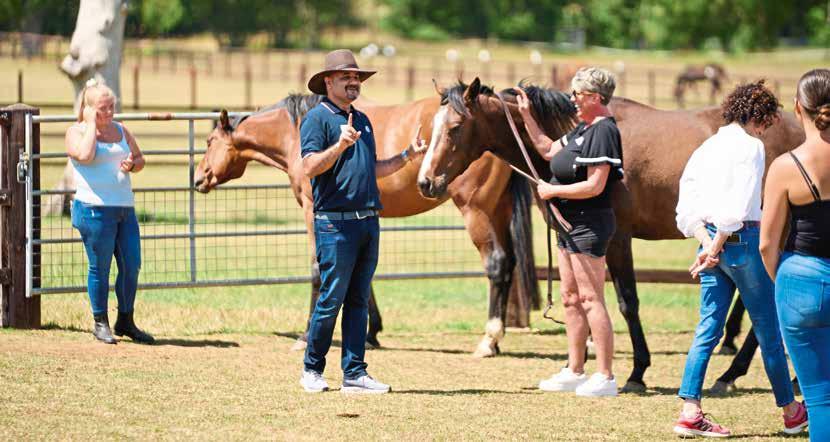
Rampal teaching on The Horseman Way
THE HARAS DE COLLEVILLE’S
GOKEN is enjoying a fine year on the track heading up the country’s leading sires’ list by number of winners (41), by three-year-old winners and is currently in seventh place on the French sires’ table by prize-money earnings.
No other sire from his year of retirement to stud in 2017, and whose first crop were arguably worst affected by the ravages of the COVID years of 2020 and 2021, is in the French top 30 by earnings.
Now at a half-way point in the year, Goken has already sired more winners than in previous seasons and looks set for his best-ever result by progeny prize-money earnings.
And with winners’ premiums having added over €700,000 to his total, and adding to the breeders’ pots too, race winners are such an important target for stallions in France.
Goken has stood at his breeder Guy Pariente’s Haras de Colleville since 2020.
By the Pariente’s own sire Kendargent, who covered this spring as a fit and active 22-year-old, Goken was the
Goken
Goken for glory
Haras de Colleville’s son of Kendargent heads up the 2025 French sires’ table by number of winners

that was dropped for the two years before he had runners to the bargain basement price of €3,000 for 2019 and 2020.
Once his stock started racing as juveniles that all changed – the Mrs Camille Vitse and Mrs Valerie Decouzbred Go Athletico won the Prix la Rochette (G3), took second in the Criterium de MaisonsLaffitte (G2) and ran in the Breeders’ Cup Juvenile Turf (G1).
His filly Livachope won three on the bounce from May to July, including the Prix du Bois (G3) and finished sixth in the Prix Morny (G1), while Axdavali, runner-up behind his paternal sibling in the Bois, took fourth placings in the Prix Robert Papin (G2),
winner of two Group 3 races, but, arguably, his career highlight came when taking third place in the 2016 King’s Stand Stakes (G1) behind Profitable and Cotai Glory. His first fee was €5,000, but
Goken: his 65 three-year-olds in training are busy winning races this season

the Prix de Cabourg (G3) and the Prix d’Arenberg (G3).
The early progeny stakes successes and placings led to Goken given a price rise of €15,000, and receiving a good book in 2021, resulting in 85 (as listed on the France Galop site), his biggest of any year to date, and the largest since the 60 foals produced from his first year at stud.
Those foals are threeyear-olds now – he has 65 in training – and are responsible for pushing his sire to his leading position as top French sire of winners and the three-year-old winners, not such an easy thing to do in a nation which concentrates its racing on that generation.
Coming along behind the three-year-old crop are 44 two-year-olds in training, and he covered 90 mares this spring.
Of course, Kendargent, the patriarch of Colleville, is still right at the helm of
things and going strong –this spring he saw a good book of 40 mares, has 27 yearlings on the ground, 53 two-year-olds and 59 threeyear-olds.
The farm’s busiest stallion in this year’s covering shed was again Galiway, who had a book of 140 mares.
The success of his son Sealiway, winner of the 2021 Champion Stakes (G1) and 2020 Prix Jean-Luc Lagardère, helped push Galiway’s book numbers up in 2022 when he stood for a first year at €30,000, a price he has maintained.
According to France Galop he has 112 three-year-olds of this year, 109 two-year-olds and 95 yearlings.
Colleville Arqana draft
At the upcoming Arqana August Sale, Colleville has a good draft of eight lots catalogued.
Lot 142 is by Galiway and out of Goken’s early headliner Livachope,
Lot 241, also by Galiway, is a half-sister to the Group 3-placed Zarakchic, Lot 215 is a Baaeed filly out of the Group 2 winner and Group 1 Golden Jubilee runner-up Restiadargent (Kendargent), while the
following lot is a State Of Rest filly out of Restiadargent’s unraced half-sister Restiamoon (Sea The Moon).
The farm has three listed in V2, including a Goken colt catalogued as Lot 358. ■
Leading stallions in France 2025




High lights
Four of Europe’s leading second-crop sires stand in France – Jocelyn de Moubray gives the lowdown on the country’s most progressive stallions
ONLY THREE OF THE TEN French-based Flat sires who covered more than 120 mares this spring have already had runners –the Haras de Colleville’s Galiway and the Aga Khan Studs’ pair of Siyouni and Zarak.
These three stallions will attract large books of mares for years to come, however, this year’s race results have shown that there are other French sires already with runners who could join them with larger books before the progeny of some of the most popular young sires like Ace Impact and Sealiway hit the racecourse.
Second-season sire monopoly
Four of Europe’s ten leading second-crop sires, those with their first three-year-

HelloYoumzain: Etreham’s leading European second-season sire has now had 44 first-crop winners
olds this year, are standing in France.
Etreham has two – Hello Youmzain and Persian King – as does the Haras de Bouquetot with Wooded and Romanised.
It is fair to say that breeders had different expectations for this group at the beginning of this year, and while Hello Youmzain covered 116 mares at €40,000, Wooded’s fee has been cut from an opening €15,000 to €7,000 and he covered 49 mares, while Romanised covered 34.
Hello Youmzain, a Group 1-winning sprinter by Kodiac, was among last year’s leading first-season sires in Europe with 21 winners and two Group winners in Misunderstood and Electrolyte.
This year he has continued to do well, but will probably have to do better still if he is to maintain his current fee.
Hello Youmzain has a new Group winner in the filly Godspeed and has sired many winners, 44 of his first crop have now won and they include three black-type winners, three per cent and seven black-type horses (seven per cent).
His progeny’s average winning distance is 7f.
It is also hard to see where Persian King’s final level will be, too. The son of Kingman has produced some high-class horses, five with a Racing Post Rating of 100 or higher, the Group 1-placed filly Cankoura, the stakes winner Darius Cen and the record-breaking sales horse Quai De Bethune and Best Secret, as well as Uthred.
There are 31 winners from his first crop so far. Persian King’s progeny’s average winning distance at present is eight and a half furlongs.
Wooded: one of only two from his generation to sire a Group 1 winner so far It is fair to say that Bouquetot’s pair of stallions have exceeded expectations. Wooded, a son of Wootton Bassett who won the Group 1 Prix de Abbaye, has become only the second sire of his generation, following Sands Of Mali, to have a Group 1 winner when

Woodshauna came last of all to head Maranoa Charlie, The Lion In Winter and Shadow Of Light to win a fiercely contested 7f Group 1 Prix Jean Prat for Resolute Bloodstock.
Woodshauna has four wins and three places from seven career starts and has been improving all year, he had beaten Sands Of Mali’s Group 1 winner Time For Sandals on his previous start.
For the time being Woodshauna puts his sire’s other representatives in the shade, but there have been 25 other winners from the 73 foals in his first crop.
Romanised has a similar record to Wooded in terms of winners, 24 so far from the 77 foals in his first crop.
The son of Holy Roman Emperor has three Group horses – the Prix Cleopatre winner Zia Agnese, Curragh Camp and Reine De Medecis, as well as high-class conditions and handicap winners, including the remarkable Young And Proud who has four wins, 17 places and €170,000 in earnings from 34 starts.
Romanised was another sound, highclass performer who won at two, three
four and five, and his five wins included the Irish 2,000 Guineas and Prix Jacques le Marois.
It is a fair bet that Wooded and Romanised will both cover more mares in 2026 than they did this year.
City is a bright Light
The Haras d’Etreham City Light retired to stud in 2020 and so the son of Siyouni has had two crops of three-year-olds to race.
He was a high-class performer, beaten less than a length in two Group 1 races, and a very sound one as he ran 22 times winning at two, three, four and as a five-year-old.
He stood at €7,000 for his first four seasons and went up to €10,000 this year when he covered 113 mares.
City Light’s first crop was full of sound tough racehorses. From only 83 named foals, City Light had 71 runners (86 per cent) and 51 winners (61 per cent), who have to date won no fewer than 123 races.
This puts City Light among the top 15 sires in Europe by wins from this crop
Persian King’s Royal Ascot winner and record-breaking July Sale lot Quai de Bethune, sold
Breeders enjoy winners, particularly in France where breeders’ premiums are so generous and so it is not surprising City Light attracted support this year which gives him a chance to move up the pecking order
behind only top sires who had 50 per cent or more foals than Etreham’s sire.
Other sires with around 120 wins from this crop are Frankel, Siyouni and No Nay Never, and only a handful of stallions have more than 60 per cent winners to foals.
It is still early days for City Light’s second crop as his progeny are not particularly precocious, but he has already had 22 winners of 34 races and this time three black-type winners (4.3 per cent of his foals) and seven black-type performers (10 per cent) headed by the ParisLongchamp Listed-winning filly Relaxx and the colt Al Aali, who ran in the Prix du Jockey-Club after an excellent second place in the Group 3 Prix du Guiche.
Breeders enjoy winners, particularly in France where breeders’ premiums are so generous and so it is not surprising City Light attracted support this year which gives him a chance to move up in the pecking order.
City Light’s average winning distance is just over a mile and his progeny are particularly effective on All-Weather tracks and good or firm ground.
Grey is good
The Haras de Petit Tellier’s The Grey Gatsby retired to stud the same year as Zarak and so has had four crops of three-year-olds to race and, although the son of Mastercraftsman is unlikely to reach the same heights as the Aga Khan Stud’s son of Dubawi, he has achieved enough to give himself a chance of moving up another level.
There were 166 named foals in The Grey Gatsby first three crops and they

include nine black-type winners, 5.4 per cent, and 15 black-type performers, 9.0 per cent.
The Grey Gatsby’s progeny have an average winning distance of 1m2f, although many of his best performers have been faster horses.
The Grey Gatsby was a winner of the Prix du Jockey-Club (G1) and earned an official rating of 127 when beating Australia to win the Irish Champion Stakes (G1) as a three-year-old.
The grey colt did not win another race despite running on for three more seasons and placing in several Group 1 races and he covered his first mares as a seven-year-old.
His first crop was headed by the Gestüt Karlshof-bred fillies Mylady and
Atomic Blonde, who were both Group and Graded race performers, as well as another filly Indian Wish, who won Listed races at around a mile for both Henri-Alex Pantall and Joseph O’Brien, and the colt Master Gatsby, a Group 3 winner at 1m6f.
His second crop included another US stakes-winning filly in Child Of The Moon and the colt Grey Tornado, a stakes winner in France at a mile while his third crop had another stakeswinning filly in Ashana.
His fourth crop is headed by the leading Spanish filly Octans, also stakesplaced in Dubai, and the sprinting filly Profumo Di Iena, who was fifth in one of the best Group 3s of the season behind the Group 1 colts Woodshauna, Time For Sandals and Maraona Charlie.
The Grey Gatsby has produced stakes winners and performers from each of his crops to date from only limited opportunities.
He has had few runners in Britain and Ireland and, because they are often in the hands of smaller trainers, and several of his better horses have been sold to race on the US.
Seven of his nine stakes winners to date were fillies, and most of them were over distances of around a mile even if he gets middle distance horses, too.
He has by far his biggest crop of juveniles to date with 85 listed on the France Galop site and 60 yearlings from the first year his fee rose to €12,000.
The Grey Gatsby has a following now and covered more than 90 mares at the same fee this year and so over the next few years will get a chance to prove his worth as a stallion.
Zarak and Galiway have had a quieter season, but both have their first twoyear-olds from a higher fee this year and so may well shine in the second half of the year, and Enzian, a close-up fourth in the Deutsches Derby on his third career start may well become the eighth Group 1 performer from the four crops Zarak produced at a €12,000 fee.
The Grey Gatsby: getting a solid following

Over the past decade, Keeneland September Sale graduates have delivered:
2,025 Graded/Group stakes wins
521 Group/Grade 1 wins
53 Breeders’ Cup wins
26 Classic Wins Internationally including two British 2,000 Guineas winners in the last six years
17 Triple Crown race wins
Euro racing

Jocelyn de Moubray meets German-born owner-breeder Marian Ziburske, who races his horses under his company name Westminster Race Horses. He has horses in Poland, the Czech Republic, France, Germany and Ireland, allies his racehorse ownership closely to his work interests, and has some big ambitions
Lady Ilze: in the pre-parade ring at Newmarket before the Falmouth Stakes (G1)
Photography by Alisha Meeder

IHAVE NO IDEA WHAT Marian Ziburske sounds like when he is talking about his key business, Westminster Property, but, when it comes to Westminster Race Horses, he speaks with such passion and speed it is difficult to keep track.
Ziburske has been a racehorse owner for 15 years, and a sponsor of races for longer. His Westminster Race Horses has had a lot of success, winning Derbys and Group races in Poland, the Czech Republic and Germany.
Over recent seasons he has changed his focus and is now looking to expand his racing operations into west Europe.
He has two of the best three-year-old fillies in Germany – the Group winners Lady Ilze and Lady Charlotte, more than 20 horses in training in France with Henri-Alex Pantall and his mares
two, changing her leads when they came out of the dip.
“I am not sure she is as good as the winner, but she could certainly have finished closer.’
De Vries is Westminster Race Horses’ retained jockey and the veteran Dutchman has been on board most of their good winners this year in Germany and in Poland.
“I am,” Zibruske laughs, “trying to persuade Adrie to continue for another season. He is a top jockey and he is a gentleman, a pleasure to work with, and an excellent speaker at our events, too. I am not sure I am going to succeed in his plans!”
Lady Ilze and Lady Charlotte, the winner of the Group 3 Diana Trial in Berlin and current favourite for the Preis der Diana in Dusseldorf at the beginning of August, were both bought

Marian Ziburske: taking a pan-European approach, and states his ambitions are to win a Group 1 and sell a horse for a million euros
westminster race horses
“We aim,” he says “to buy horses who are going to race between 2,000m and 2,400m, and 70,000gns is the most I have spent on a yearling – we are looking for horses whose pedigree is not too commercial.
“I have had a lot of success with Territories and Lady Ilze’s dam is the type I like, a good tough racemare, by the good broodmare sire Intikhab, who was not black-type.
“I met the filly’s breeder Lulu Winter afterwards and I sensed that not only is she enthusiastic about breeding, but she believed Lady Ilze is a special filly.
“She was probably disappointed when I said the filly would go to Poland but now we are in touch regularly and I hope in the future she will be able to sell the mare’s progeny for more money.”
ZIBURSKE BOUGHT Lady Ilze’s half-sister by Lope Y Fernandez, named Lady Liva, for only 4,000gns the following year and he has high hopes for her, too –she was second on her debut in what was by Warsaw standards a super maiden with €11,500 on offer.
Ziburske was brought up in Dusseldorf and then in Berlin. His parents had no interest in racing but his grandmother, who lived in Neuss, loved the sport, and when he went to stay with her, they would always go to the racetrack together.
“Sadly, Neuss racecourse no longer exists,” he says, “but I remember clearly my first visit there when I was very young, and my first winning bet.”
Ziburske started Westminster Property in Berlin in 2010, the company and its off-shoots have become successful and has expanded into Poland, where he lived for nearly five years, the Czech Republic, and more recently into Italy, where he is now based, and to the Baltic States.
“I have,’ he adds, “always loved racing and it is also something I share with my wife and children.
“My wife and two daughters ride most days and compete in show jumping events, while my son doesn’t ride but he is fascinated by pedigrees and the sales so racing is something we can all share.”
Westminster has about 70 horses in training, with 25 now with Pantall in France.
The yearlings start in Poland and those who show enough ability as juveniles are transferred to Wöhler in Germany for
their three-year-old careers.
“My French horses tend to make money, my German horses generally lose money!
“But I can make that up by selling the better ones, usually in France,” Ziburske reasons, “and I do not burn money in Poland either and I tell my trainers there that they have to be efficient.”
He adds: “In the long run, Pantall will have more as I now have about 18 mares
The horses are all named after business colleagues and associates, and business partners are given days out at the races: Ziburske can’t understand why more businesses don’t make more use of racing
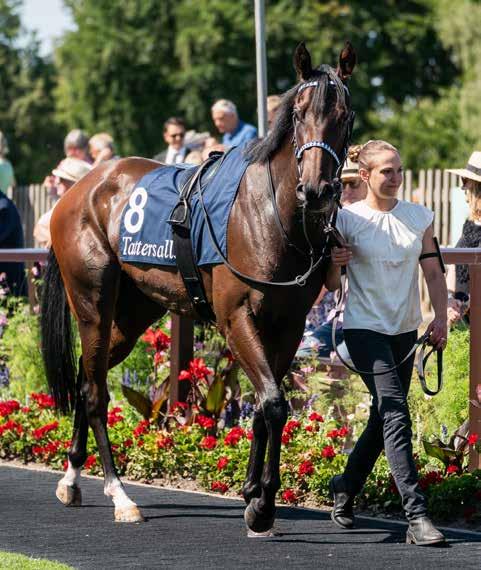
based at the Haras de Beaufay and the French-bred foals will go to him.
“France is the only country where you can make money racing with average horses. I met Pantall at the races as he often has runners in Germany and I sent him horses such as Good Gift and Sir Siljan, who had done well in Poland and suggested he ran them in claiming races.
“He soon told me they were better than that and both are now competing successfully in Listed and Group races.
“Tomas does an excellent job selecting the yearlings we buy and Andreas gets the selection of the selection.”
He continues: “I have six horses with him today and, aside from the two excellent fillies, they are all good horses.
“I may send Wöhler more in the future, but proven horses rather than yearlings which suits him, too, and my Polish trainers get a bonus if one of theirs goes on to win a Group race in France or Germany.”
ITALY MAY BE THE next country Westminster Race Horses expands into as Ziburske is now based in Varese in Lombardy, and has a couple of horses in training with Bruno Grizetti and Endo Botti.
“I had my first Italian runner recently,” he says, adding with a laugh, “Unfortunately the race was late in the evening, and I was at the opera in Milan with my wife.
“I had to watch my phone hidden in my programme, and we finished last!”
Westminster also has a two-year-old called Duke Of Cumberland, and he is in training in Ireland with Joseph O’Brien.
“I have,’ he says, “been a sponsor at Hoppegarten for longer than I have been an owner and Westminster is the main sponsor of the Grosser Preis von Berlin, which O’Brien won with Al Riffa.
“Gerhard Schöningh, the owner of the racecourse, and I enjoyed meeting Joseph and decided it would be fun to have a horse with him together.
My French horses tend to make money, my German horses generally lose money, but I can make that up by selling the better ones, usually in France
“We bought Duke Of Cumberland, a son of New Bay, and the colt has had one run.”
Sponsorship is another aspect of racing Ziburske enthuses about – his racehorses and his businesses are closely linked.
“One third of the horses are called Westminster something after the company, one third are named after members of staff, Charlotte is a secretary in our Warsaw office for instance, and then one third are named after business partners – Ilze is a formidable businesswoman and one of our main partners in Riga,” he explains.
“When I sponsor races in Hoppegarten, at Sluzewiec racecourse in Warsaw or, as most recently at Cagnes Sur Mer, I invite 70 to 90 business partners and others
associated with our business.
“We have them for the whole afternoon, we entertain them, take them to visit the racecourse and stables and then they can watch and follow horses named after them.
“The weather is not great in the Baltic States or Poland in February and so many were only too happy to come for an outing to Cagnes Sur Mer where the weather is pretty good at that time of year!
“I do not really understand why more people don’t take advantage of what this type of sponsorship can develop.”
Another aspect of Westminster Race Horses is charity events. It has a big charity day at Sluzewiec in Warsaw, attended by more than 12,000 people at

Lady Ilze with Adrie de Vries finishing fifth: Ziburske enjoys working alongside the leading jockey

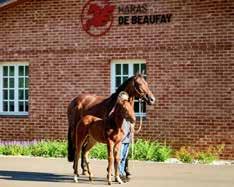
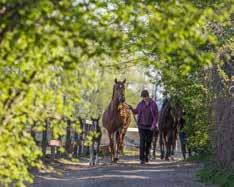

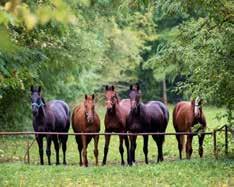

its most recent edition, and in Dresden.
“I am,” he explains, “attached to the city of Dresden, I met my wife at the opera there, and every year we hold a day at the races for a school for children with learning difficulties.
“We invite 300 kids to Dresden racecourse, get them involved forming different teams of supporters, Adrie goes to speak at the school and any money we make goes back to the school.
“This, of course, has nothing to do with my business, but I enjoy the day and helping children.”
Having raced through the many aspects of Westminster Race Horses and the different countries it participates in, Ziburske returns to his current priority, winning a Group 1 race and specifically winning the Group 1 Preis der Diana with his Golden Horn filly Lady Charlotte.
“Lady Charlotte has,” he says, “always been a big, strong, good-looking filly. She is by Golden Horn from a staying
We invite 300 kids to Dresden racecourse, get them involved forming different teams of supporters, Adrie goes to speak at the school to help them understand the sport
family, but was winning over 1,300 and 1,400 as a two-year-old in Poland.
“ When she moved to Wohler, she won a Listed and then her Group 3 and so decided to try running her in the Derby.
“Unfortunately, she had stall 18 and
when the gates opened our plans fell apart. She flew out and ran through the first part of the race far too fast. Adrie was taken by surprise, and it took him a long time to get her settled.
“There was not a fast pace, and when it came to the end of the race she was unable to accelerate and finished only eighth. She is still favourite for the Diana and so I am not the only one who believes she is capable of better.”
Ziburske and Westminster Race Horses have already proved to be innovators, the model it is following is an original one and is working very well indeed.
Its sponsorships and charity events have brought new people into the sport and helped to renew it in places such as Warsaw, Berlin and Dresden.
It is hard to know where Westminster Race Horses will be in five years’ time, but it will surely still being trying new things and Ziburske himself will still be happy to talk through every aspect.
Young horses are based in France at Haras de Beaufay and Haras du Chene, in Poland at Stadnina Koni Krasne and in the Czech Republic at Hřebčín

Chantilly-based trainer
Josephine
Soudan has enjoyed a superb 2025 and a particularly good June, reports
Jocelyn de Moubray
JUNE WAS A GREAT MONTH for Josephine Soudan and her Chantilly stable.
On the first day of the month, the day of the Group 1 Prix du Jockey-Club, the stable’s two-year-old Graft won a Listed race at Chantilly, defeating runners trained by Karl Burke, Francis=Henri Graffard and André Fabre.
The son of US Navy Flag won carrying the colours of Racing 92 rugby star Henry Chavancy, a school friend of Soudan’s, but was then sold and became his trainer’s first runner at Royal Ascot, carrying the colours of Ali Aneizi of Benghazi’s Al Watan Club to finish a respectable seventh in the Group 2 Norfolk Stakes, less than 6l behind the winner Charles Darwin.
A winner on Jockey-Club day, a runner at Royal Ascot and then a succession of winners, five of the last 15 runners - not a bad June at all.

It has come together this year for Soudan

Graft is a small colt, he is just about 15hh, and I was worried he would look ridiculous in the paddock at Ascot, but I do not think he did, and he ran a great race
And it is this sort of success which allows a small stable to be noticed –when the stable’s runners have appeared on Equidia the commentators have started to say, “one from the Soudan stable, which is in such good form.”
After eight years as a small trainer Soudan, who started out with two horses in her care and currently has 23 listed on the France Galop site, is not about to get carried away, but she too believes the stable is in a good place this summer.
“When I started out,” she explains, “I had four magical years, good horses, good clients, and winners, and then some difficult ones.
“I made mistakes. I had more horses,
but to get there I took on owners, staff, and horses I should not have.
“Some of the owners didn’t pay their bills, the horses were not as good or as sound and then COVID was, of course, a difficult time for every small stable.
|There was no racing for weeks and then when it restarted it was more difficult than ever to win races as every stable had horses ready and waiting to run.”
She outlines:“I try to keep my training fees reasonable, but this means that, if the business is to keep going, we need to have horses who are winning or finishing placed and winning prize-money.
“Now we have good quality horses,

Left, Josephine Soudan at Royal Ascot, below, Graft, by US Navy Flag, going to post for the Norfolk
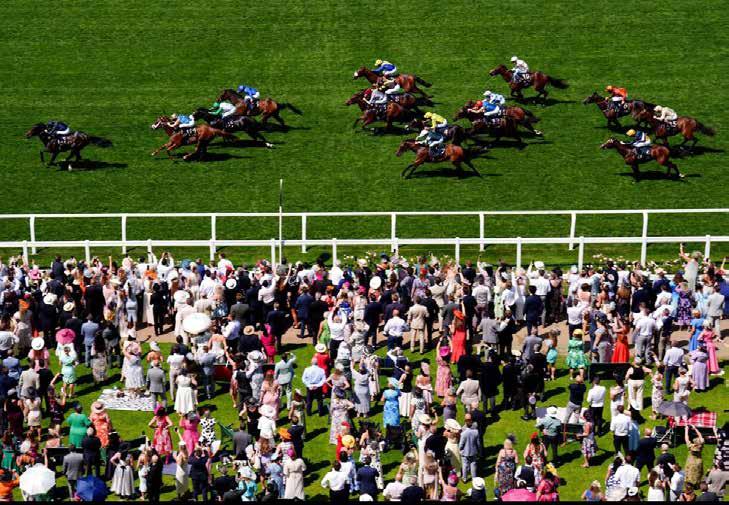
who have been well raised, many of them never need to see a vet which is not, I believe, a coincidence.”
Soudan certainly enjoyed her first trip to Royal Ascot as a trainer.
“We were,” she says, “very well received, the staff and the stabling well organised. The only scare we had was walking out of the customs office in Dover and realising we had a flat tyre!
“We were saved by Greek truck drivers who we had been talking to, they changed the tyre while Graft stayed in the box without moving.”
Graft is small in stature which probably helped with the tyre changing,
but his smaller size was a worry to Soudan ahead of the race.
“He is just about 15hh, and I was worried he would look ridiculous in the paddock at Ascot, but I do not think he did, and he ran a great race.
“We have since given him a short break as he has had several races close together and we shall try to win another Listed with him over a straight 5f in Deauville in August.”
Soudan’s family has no connection at all with racing, her father was on officer in the French navy, which inevitably meant that she moved around during her childhood and spent a fair amount of the
period near the French naval bases of Toulon in the south of France and Brest in the west.
“I always wanted to ride horses,” she remembers, “from a young age and in Toulon we lived opposite an equestrian centre, where I spent as much time as possible and competed in show jumping events.”
Through a friend of a friend she managed to get an introduction to the Maisons-Laffitte-based trainer Didier Prodhomme and did some work experience in his stable, but her first real introduction to the thoroughbred world came when she managed to get a
Graft finishing seventh: Soudan thanks a bunch of Greek truck drivers who came to her rescue at Dover fixing a flat tyre on her lorry with the horse on board
summer job doing sales prep for Haras d’Etreham.
“If you come from outside the racing world,” Soudan explains, “and have no idea what a yearling for sale looks like it is quite an experience to go to one and work for a farm like Etreham!
“I was bowled over by the atmosphere, the excitement, and also by how professional and how well organised the Etreham team was and is. I left Deauville that summer determined that I would work in the racing world.”
As well as riding horses, the young Soudan loved sport, playing sport, watching sport, and thinking about sport, how to prepare mentally and physically to succeed in sporting events.
As a result, she naturally decided that, rather than looking for experience working on the breeding side of the business, she would instead find out about training.
“I wanted to try to get on the Darley Flying Start and so I went to a business school in Paris and was able to persuade those responsible that, rather than doing work experience in a normal business. I was going to work for the Chantilly trainer Pascal Bary,” she continues, adding: “I ended up working for Monsieur Bary for two and half years.”
The next stage of Soudan’s learning process was to travel – unfortunately she missed a spot on the Flying Start – so she took herself off to Australia, dividing her time between Sydney and Melbourne and particularly enjoyed her time working for Mick Price.
She went on to England where she spent five months with Marco Botti and then a year and a half working for John Gosden.
“It was,” Soudan remembers, “the time of horses like Kingman, The Fugue and in the yard I worked in we had the Group 1 winner Sultanina.
“My yard was on the way between the office and the gallops and so Mr. Gosden was always coming through and we often had time to speak. I learnt a great deal and would have loved to have been a
Mr Gosden told me that I should try to become a trainer myself – he said that in life you always had to try as, if I didn’t, I would never know whether or not it would have worked
trainer in Newmarket, but it was never going to be feasible financially.
“Mr Gosden told me that I should try to become a trainer myself – he said that in life you always had to try as, if I didn’t, I would never know whether or not it would have worked.
“It is a simple phrase but one which stayed with me.”
At that point she was not quite ready for that leap of faith and on returning to Chantilly she spent a final season with Bary and then, to see a different approach, four months in Royan with Guillaume Macaire, who she describes as fascinating and “très sympathique”.
She then started out on her own in Chantilly with two horses.
THE FIRST YEARLING she received was the Jean Louis Bouchard-owned Marouba, who went on to become her first two-year-old winner and then her first Listed winner.
“I never really thought about setting up anywhere else in France,” she says.
“I didn’t want to be isolated in the country somewhere and, if you want to do something as well as possible, it makes sense to work on the best gallops, and Chantilly has the best facilities.”
The stable’s owners today include
Gerard Augustin Normand, Peter and Roderick Kavanagh, Barbara Moser, who raised Ace Impact and other champions, Chris Wright, and other well-known figures in the bloodstock world.
“I have never met Monsieur Augustin Normand in person,” she says, “even though I have had horses for him for seven years, however, every time I run one of his horses, even if it is late at night at a tiny country track, we speak immediately after the race, which he has always watched and he is always interested. It is a pleasure to work for him.”
Roderick Kavanagh is the breeder of Graft and sent the colt to Soudan telling her she should try to win a claimer.
Asked what her ambitions are for the future Soudan has some clear principles.
“I want to have a stable which is consistent,” she states. “I dream of having good horses, not necessarily a vast number, and I would like to make my clients happy, while respecting my horses.
“I think that as a trainer the hardest and most satisfying thing is to exploit a horse for a career, to allow it to improve, progress and repeat its good performances.”
She quickly adds that in her current yard there are 42 boxes and so she has the place to expand!
If at the beginning her family knew nothing about horses or racing, they are now enthusiastic followers.
“I have sisters, nephews and others who follow the stable closely,” she laughs. “I have to send out an e mail with my expectations for every runner as before they used to be worried or disappointed every time we didn’t win.”
Soudan has ten two-year-olds yet to race, some promising three-year-olds such Kavanagh’s Rastrellare, the winner of two sprints already this year, and Light The Ghost, a Waldgeist filly who won well at Compiegne during June, and, of course, the diminutive Graft.
It looks as if a page has turned and the Soudan stable is in a good place, ready to win races with good and healthy horses.

Moving on UP
Pierre-Hugues Henry and Janine Gandy at their new farm in the west of France: the couple are looking forward to selling for the first time at the Arqana August Sale
arqana consignors
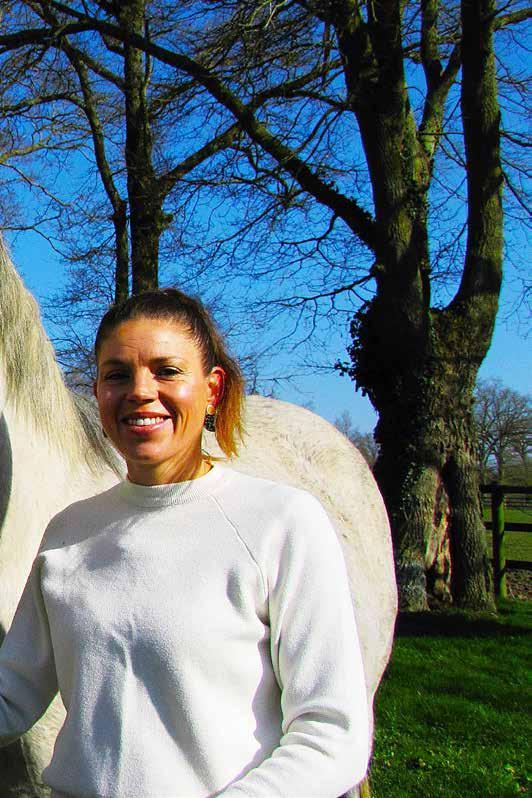
Windermere
Stud
is based in the heart of the French countryside, is named after a barn at Arrowfield Stud in Australia and is a debut consignor at this year’s Arqana August Sale. Adrien Cugnasse finds out more
WINDERMERE STUD: from Australia to the heart of the French countryside. After four years in the southernhemisphere and then 11 years working alongside Alban Chevalier du Fau in his consigning, pre-training and breeding operation The Channel Consignment, Pierre-Hugues Henry and Janine Gandy have decided to go on their own – the couple has launched Windermere Stud, their own business based in the heart of the countryside in western France.
And the pair got off to a flyer making a successful debut at the Arqana Summer Sale, and on the back of that first foray are offering two yearlings at the August Sale, which is in itself is something of a remarkable feat for a consignment in its first year of existence.
The story of Australian-born Janine Gandy and the Frenchman Pierre-Hugues Henry began in a barn at Arrowfield Stud in Australia called Windermere.
The pair met during Henry’s four-year stint working at Arrowfield when he says he “started doing a bit of everything and then worked as a stallion man”.
Gandy, originally from western
Australia, moved to work at Arrowfield having been based on farms and at a veterinary clinic in the west joining Arrowfield six months after Henry.
In 2013-14, the stud took the opportunity to shuttle its leading sire Redoute’s Choice to France, and it was Henry who was entrusted with the great responsibility of taking care of the legendary Australian sire during his two years in Europe – as he says being French and having worked at the Aga Khan Studs probably helped with his selection process!
The couple transfered back to France, and eventually left the stallion world, moving on to become key players for The Channel Consignment.
Run by Alban Chevalier du Fau, it is one of the leading consignment
operations in French stretching across sales of both codes, but the couple’s role also encompassed working in the breeding arm of the business, notably managing the mares of the Marquise de Moratalla.
The pair handled – whether in breeding, sales prep, or pre-training –a large number of Group performers, both on the Flat and over jumps, roles which afford them some broad-ranging top level experience.
The ideal location
Now, some 15 years after they first met in Australia, the couple has set up their own business in western France, the region in which Henry grew up. Although widely known for producing
high-class jumpers, who shine on the Anglo-Irish NH scene, the area has also been the birthplace of several notable Flat horses.
The couple searched for the right place to settle, and that goal was finally achieved last winter – the new consignors have taken over the property long used by trainer Norbert Leenders.
“Originally, the site was a stud farm, and Monsieur Leenders converted it into a training facility after purchasing it,” says Henry.
“For prepping stores and yearlings, it’s ideal – there are plenty of boxes and paddocks, as well as a horse walker and a Havrincourt ring.
“It’s particularly well suited to this kind of work, and preparing horses for sale, both for the Flat and jumps, will be
Hazelwood embarking on a French adventure
Leading Newmarket-based farm and consignor on a debut mission to Arqana
HAZELWOOD BLOODSTOCK
well known as a consignor of top-class yearlings, is heading in a new direction this year and over the Channel.
Rather than doing the usual and offering all of Hazelwood Bloodstock’s yearling draft at near-at-hand Tattersalls, as the farm has done since it started up in 2016, two of its colts are due to ship to Normandy, catalogued in the Arqana August Sale.
Hazelwood, run by Adrian O’Brien and wife and vet Philippa, really is at top of this business – it has three seven-figure yearling sales under its belt and
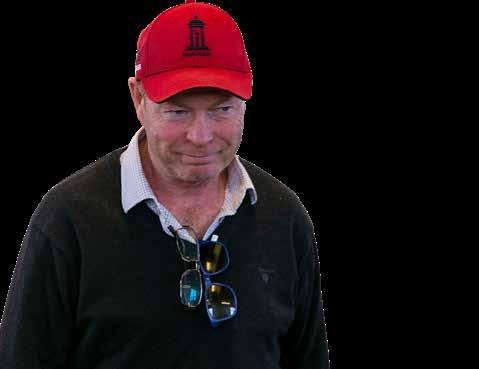
a top price of €3,600,000gns given in 2019 by Godolphin for Noble Dynasty, the Dubawi colt out of Alina, the highest-priced yearling colt in the world that year and subsequent winner of the Group 3 Criterion
But this is a first overseas selling venture for the farm, which is based just outside of Newmarket, Adrian O’Brien explains the concept behind the
“We are dipping our toes in the water,” he says. “We have been thinking of this for a while, it is not something that we have ever purposely avoided, and this year I felt we had a couple of horses who were particularly mature and I thought they’d be suited to
The two colts have spent most of their young lives reared at Hazelwood (Lot 87) born and raised on the farm, the American having arrived from
Aside from the maturity both
Adrian O’Brien: dipping a toe in the water at the Arqana August Sale
a significant part of our business.”
He adds: “The property spans 30 hectares, and we have a small band of resident mares. Throughout the breeding season, we also welcome visiting broodmares for foaling or covering.
“We’re located near several studs with stallions, and Normandy isn’t far away either. This region has a proven track record when it comes to breeding.
“Richard Corveller and Marie-Laure Collet are not far from here. Being based in Mayenne, on good breeding land and close to Normandy, is a great compromise. We’re also close to the Meslay Equine Clinic, which is a bonus.”
A spectacular debut
At last month’s Arqana Summer Sale,
The successful sale in July allowed us to make many valuable connections – we received a lot of kind messages, which was great
Windermere Stud offered nine stores achieving a 100 per cent clearance rate.
Among the buyers was Margaret O’Toole, who signed for two horses, including a striking son of Doctor Dino who fetched €135,000, making him the third top-priced two-year-old store.
“It was quite unbelievable for a first time,” enthuses Henry. “We were absolutely thrilled. So many clients supported us, it was fantastic.
“From start to finish, everything went perfectly and it was wonderful to see
have shown since the start, O’Brien feels that their pedigree profiles will be suitable for the French market in August, and will also prove attractive to the international buyers who flock to Deauville that month.
“The No Nay Never colt out of Gabrielle has a French pedigree,” he outlines. “The mare was trained in France and is from the immediate family of Look De Vega, the winner of the Prix du Jockey-Club last year. So it makes obvious sense.
“As for the American Pharoah – the sire has obviously had winners in all jurisdictions around the world, and I thought the likely diverse buying bench would be a good fit for him.”
But, as ever for Hazelwood, it is the physicals that are the most important and as O’Brien confirms,“I hope everyone else agrees with me when they see them, but I think they should stand up as really mature, forward horses.”
And while Hazelwood will obviously continue to stay close to home and sell at Tattersalls with the bulk of any future drafts, selling again in Normandy is definitely something that he wants to become perhaps a bit more usual.
“We have Tattersalls on our doorstep, and it’s a great venue to have so close, and of course we’ve readily avail of that – it is great to get home to your own bed after a day at the sales!”says the consignor, adding with a smile: “But we are keen to broaden our horizons a little.”
The two-strong Arqana draft is due to sell through the August Sale’s second session on the Sunday, so the plan is to travel from Suffolk the previous Monday to start showing on Wednesday.
Mrs O’Toole purchase two of our horses. We’re delighted to be working with such people from the beginning.
“The successful sale in July allowed us to make many valuable connections – we received a lot of kind messages, which was great.
“All the feedback was positive – on the horses’ presentation, the welcome we were given, the details of our uniform.
“Now, we’re also very excited to be taking part in the August Sale for the first time.”
Hazelwood Bloodstock draft Arqana August
Lot 87 colt No Nay Never Gabrielle Dark Angel Lot 259 colt American Pharoah Singing Sweetly Galileo
The couple have been extremely successful selling and producing top-class horses – the 219 lots offered by Hazelwood at Tattersalls have achieved an average price of 131,000gns, and the farm’s graduates are headlined by the US Grade 1 winners McKulick and In Italian – but despite his experience O’Brien has not been shy to seek wise counsel from others for this new venture.
“Everything we are doing for this I am basing it on advice that I’m seeking, I feel like a rookie!” he laughs.
O’Brien as a hands-on horseman is likely to travel with the horses, and has obviously been to the Arqana venue previously, but he does admit that it has been some time since visiting Deauville – as to be expected, the busy man does not like to be at a sale as a spectator and without a job to do.
Looking further ahead to the farm’s usual Tattersalls October draft, O’Brien believes that it is of particularly high quality and enthuses: “I think we have an extremely select Book 1 draft this year, and I am very pleased and it includes colts by stallions such as Frankel, Lope De Vega and Dubawi.
“It is a very good draft, the horses match up to the pedigrees, and I do think it as strong as we have had.”
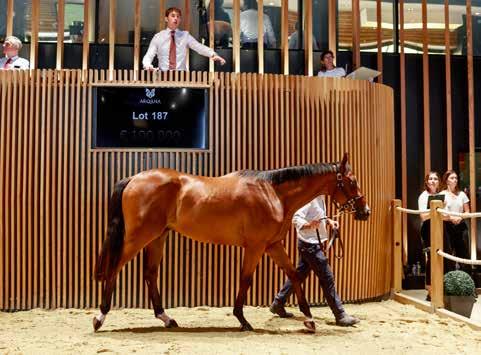
Talented pinhookers
The couple had already been trading pinhook horses and have their names by a horse who could go to the top.
After April’s Prix Amadou, a Grade 2 over hurdles, trainer Yannick Fouin declared about his winner Six Figures: “We’ve got a very good horse here – he’s among the best I’ve ever trained…”
Words such as this coming from the man who shaped Impaire et Passe and Lossiemouth in their early days, is quite a statement.
Last November, Six Figures had shown a first glimpse of top-class ability when third in the Grade 1 Prix Cambaceres for three-year-olds, and he has recently built on that with a close third in May’s Grade 1 Prix Alain du Breil (G1).
The son of Harzand has yet to debut over fences, but many believe he could become one of the star chasers of Auteuil for the next seasons.
Six Figures was bought as a foal at the Tattersalls Ireland November NH Sale by a group of French pinhookers – led by
Windermere Stud draft Arqana August
Their first August yearlings
Many of the members of the Six Figures pinhookers group have continued the adventure with Windermere Stud, this time with the two Flat-bred yearlings to be presented at Arqana August.
One is a son of Pinatubo (Lot 122), bred by Guy Pariente and hailing from one of Haras de Colleville’s strong speed families, and he cost the pinhookers €85,000 as a foal.
The other is a filly from the first crop of State Of Rest (Lot 231), a half-sister to two black-type performers and a member of one of the most active families nurtured by the late Lady O’Reilly. The filly was a 45,000gns purchase.
“This plan was organised last December,”says Henry, “and we bought at Arqana and at Tattersalls. The idea, if we could get up and running in time, was to present them at the sales.
“The good news is that both were selected by Arqana, and we are thrilled to be featured in the prestigious catalogue.
“The filly comes from a family that’s well known in France and State Of Rest was a globetrotter and a superb racehorse.
“She’s a lovely filly with a great walk – she should attract attention, I hope.
Gandy and Henry, who took the rare step of buying a foal in Ireland and shipping him to France.
The Irish certainly didn’t do the French buyers any favours on price, and the Vambeck Bloodstock Ltd-bred colt cost the group €36,000.
Two years later, there was little buzz in the Arqana sale ring when the son of Harzand was offered for resale under The Channel Consignment’s banner – he was bought back for €45,000.
A pinhook failure – but perhaps not a sporting one, or now a commercial one.
The group decided to race the horse themselves – he has already earned €181,460, prominent owner Alain Jathière acquired a 30 per cent share, and Six Figures will continue racing in France.
“With the Pinatubo colt, we’re leaning more toward speed, both on paper and physically. He’s a powerful individual with an impressive frame and movement. Physically, he should appeal.”
Pinatubo boasts the best ratio of black-type horses to runners among his generation of stallions.
“All he needs now is a top-level performer to enhance his commercial appeal, and some trainers have a few very promising Pinatubo’s sons and daughters,” outlines the consignor working his sales pitch.
It is an exciting time for the couple, who have taken a name from Australia, embedded it in the French countryside, and have already made a mark with its graduates.
First success: the son of Doctor Dino sold by Windermere Stud at the Arqana July Sale for €135,000
Photo: Zuzanna Lupa, Arqana




A
GROUP 1 WINNER

G1 Grand Prix de Paris
Bought by Jean-Claude Rouget

G2 Prix de Sandringham
Bought by Carlos & Yann Lerner






















































By leading sires such as Wootton Bassett, Siyouni, Zarak, Lope de Vega, Mehmas...









THE NAME JEAN-PIERRE
DUBOIS is almost completely unknown outside of France, but he is a true racing legend.
The news of Dubois’ major dispersal caused a sensation in France, as the man embodies the success of a self-made individual who started from nothing and reached the summit of trotting, Flat, and jump racing.
Legend has it that he arrived in Normandy from his native Brittany in the 1950s with almost nothing – just a moped and two modest trotters.
Now, 70 years later, Dubois is one of the largest landowners in Normandy.
As a trainer, driver, breeder, and owner, he has won all the major trotting races, and is considered in the sport the French equivalent of John Magnier.
In Flat racing, he has produced two Prix de Diane (G1) winners, Stacelita and Sparkling Plenty, as well as the Classic-winning Olmedo, Sauterne, winner of the Prix du Moulin (G1), and Noble Truth, who took the Jersey Stakes (G3).
Over jumps, he has bred numerous Grade 1 winners, including Feu Follet and Salvator Mundi, and it was Dubois who discovered and first trained the legendary Kotkijet, widely regarded as the best steeplechaser ever seen in France.
Incredibly, Dubois is still driving in trotting races even in 2025.
His latest victory dates back to August 2024 – when he was already 84 years old!
An enigma
Very few people can truly claim to know Jean-Pierre Dubois. In any case, he is almost impossible to interview.
Not because he is unfriendly with journalists, but rather because he is far too clever to ever say what he really thinks. His favorite answers to journalists’ questions are always the same: “You know, I’m just a small
breeder, a simple farmer who’s been very lucky.” Or, alternatively: “And what do you think? What’s your opinion?”
Nevertheless, one person did know him well: the trotting trainer PierreDésiré Allaire, who passed away in 2020. He was born in the house next door to Dubois, and throughout their lives the two men were rivals – and sometimes partners as well.
In the early 2000s, Allaire explained: “He’s made differently. Not like the rest of us. He doesn’t have the same constitution as you or me.
“When he was three and a half, after being scolded by his father, he grabbed a suitcase and ran away from home to go to his grandfather’s house a few kilometers away. The German soldiers who saw him laughed, my mother brought him back to his parents.
“But what a show of independence for such a young child! Jean-Pierre was always ahead of his time, and even at 13 he was as mature as a grown man.
“He’s not made like others. Maybe he has Cossack blood! With those blue eyes of his, he looks like one of those horsemen from the steppes…”
He’s retiring… almost!
When interviewed by the regional newspaper Ouest France, Dubois stated plainly: “I’ve decided to stop… Age is catching up with me. We’re selling everything.”
But reading between the lines, it means that Dubois, who turned 85 in July, will be merely stepping away from large-scale breeding and that he will retain a small number of horses he holds particularly dear.
It is hard to imagine, for example, the great breeder parting with Speralita by placing her in a sales catalogue.
Dubois also owns horses in partnership with friends, associates, or family members. And all these horses, such as Sparkling Plenty, who fetched £5 million at the 2024 Goffs London Sale in a private sale after the auction

Jean-Pierre Dubois bows out (almost) at Auctav
ON WEDNESDAY, August 13 at Haras de Bois Roussel, Auctav is organising an historic private sale that will feature over 100 thoroughbreds and will include foals, broodmares, yearlings, as well as horses in training, both Flat and NH, as part of the dispersal of Jean-Pierre Dubois’ stock, writes Adrien Cugnasse.
Headlining the sale is Sofia (Kingman), a full-sister to the 2024 Goup 1 Prix de Diane heroine Sparkling Plenty.

She will be sold in-foal to Starspangledbanner, and the seven-year-old is from the family of Noble Truth (Kingman), Stacelita (Monsun), Sauterne (Kingman), and Soul Stirring (Frankel).
Also catalogued are Frisella (Frankel), the dam of the stakes-placed Grand Scoop (No Nay Never), who is in-foal to Blue Point, two half-sisters to the Group 2 Prix de Sandringham winner Purplepay (Zarak), Salerne (Charm Spirit), a half-sister to the Group 1 Prix du Moulin heroine Sauterne (Kingman) and in-foal to Auguste Rodin, the multiple Listed winner Blue Wings (Wings Of Eagles) carrying to Ace Impact, and Helenium (Frankel), a half-sister to the Royal Ascot star and late sire Calyx, carrying to Kingman.
“This is a historic session,” acknowledges Auctav’s general manager, Arnaud Angéliaume.“We are honoured to host the private sale of Jean-Pierre Dubois.
“He is a man whose life has been an extraordinary human and professional journey. He has shaped racing in France and around the world, in both Flat, jumps and trotting racing.”
finished, and then €5 million in 2024 at the Arqana Breeding Stock Sale, will not be going through the Auctav sales ring. Nonetheless, with the sale set to be staged just days before the Arqana August Yearling Sale, a large crowd is expected at Haras de Bois Roussel, especially as Dubois is selling a large number of fillies from his top families.
A very different culture from Flat racing In Ireland and England, trotting is almost completely unknown, but in France, it is the number one racing sport in terms of foal production (over 14,000 trotting foals as against 8,000 thoroughbreds) and number of races with more than 11,000, which is twice as many as Flat and jump races combined.
Trotting is a tough world, largely because it is common for one person to wear all the hats: owner, trainer, breeder, and race driver. Dubois got to the head of the sport thanks to his extraordinary intuition.
Trotting is a fairly traditionalist sport, at present, and for much of its history, the French stud book is closed, meaning it is impossible to use non-French blood.
However, in the 1980s, there was a brief opening that allowed the use of US bloodlines. At the time, Dubois, despite not having the money, shipped his best mares by plane to be covered by the top stallions standing in the US.
He was one of the very few to take this risk. It was a bold move that paid off –the stud book closed again a few years later.
But with the injection of US speed into his stock, Dubois stood the best trotting stallions in France for decades, much like Coolmore made its mark by sourcing sons of Northern Dancer from the US.
This decisive choice and success allowed Dubois to buy stud farms in Italy, the US, and all over France.
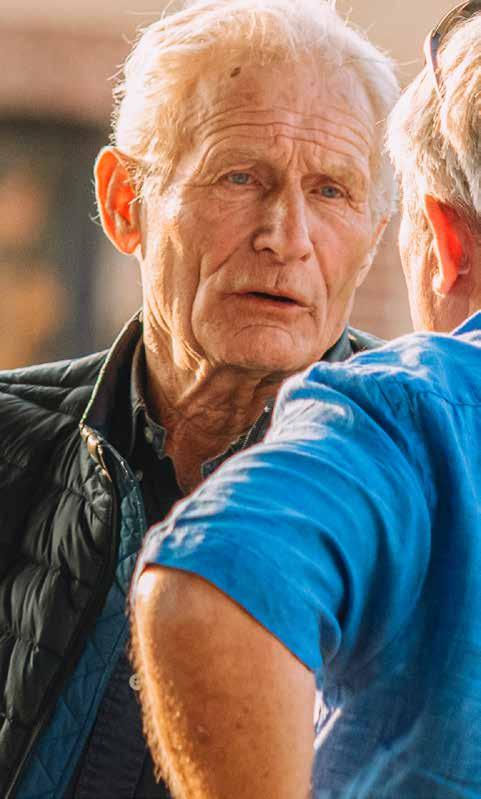
Jean-Pierre Dubois: drove his most recent trotting winner last August as an 84-year-old
And in Italy, he bred Varenne, who is the trotting equivalent of Frankel.
Traditionally, trotting people are less inclined to sell their horses, and there isn’t really an international market as in the thoroughbred world.
As a result, trainers and breeders can work as they please without worrying about an owner’s or a sale ring opinion.
So, perhaps as to be expected, Dubois bought that view to his Flat racing operations – in 2021 he did something quite astonishing, perhaps common in trotting but unheard of in Flat racing, he began using the young thoroughbred stallion Chachnak as a sire midway through his racing career!
A dual Group winner at three in 2020, Chachnak covered 49 mares in 2021. He then went on to win another race as a five-year-old in 2022… the same year he covered 30 mares!
He’s not cut from the same cloth
In France, absolutely everyone in racing has a story involving Dubois.
Apparently, at the age of four, he noticed a charabanc (wagon) with a horse harnessed in the courtyard of the family farm. The young child climbed on board and released the brake. What followed was a wild chase through the streets of Dinan, with his parents frantically pursuing the runaway carriage – and all under the eyes of the occupying German army.
His entire life has been about disruption and an unrelenting drive to forge his own path.
Some recall flying with him to Kentucky to buy mares at Keeneland, but, instead of resting after the flight, Dubois spent the entire night testing trotters on a floodlit track!
Even after amassing a fortune, he would still mow his own hay through the night after a day at the races.
A few years ago, an admiring young breeder approached him at the sales and asked if he had a NH broodmare for sale. Dubois replied: “Sure, of course – what
As recently as four or five years ago, you could spot Dubois in Milan on a Wednesday driving a trotter in a race, two days later at Arqana, and by Sunday in Madrid with a Flat runner!
colour would you like?”
Alongside his son Jean-Etienne, Dubois Snr was part of the team of mad pinhookers who bought Onesto for $535,000 at the Ocala Breeze-Up Sale. Who buys a two-year-old for over half a million hoping to resell it on the racetrack?
And yet, it the brave move and investment paid off: Onesto went on to win the Grand Prix de Paris (G1), and finished on the podium in the Irish Champion Stakes (G1) and the Prix de l’Arc de Triomphe (G1).
A special connection with the Wildensteins In the 1980s, the Flat racehorse owner
Daniel Wildenstein decided to enter the trotting world, but, given as he was then a 70-year-old, he didn’t want to waste time building a breeding operation from scratch.
The problem for Wildenstein was that, as already mentioned, unlike in Flat racing, the tradition for trotting people is not to sell horses – the one exception being as might be expected Dubois, who had always been open to trading.
So for years Dubois sold entire generations of horses to Wildenstein, allowing the latter to win major international trotting races.
During this period, Dubois also managed to acquire well-bred thoroughbred fillies from Wildenstein

The sale, to be staged at Dubois’ farm Haras du Bois Roussel, which is used for Auctav’s auctions
During this period, Dubois also managed to acquire well-bred thoroughbred fillies from Wildenstein—and he became captivated by the challenge
– and he became captivated by the challenge.
Over the past few decades, the money he earned from trotters enabled him to invest seriously in Flat racing.
It is therefore no coincidence that Olmedo, Parnac, and the majority of his top thoroughbreds come from Wildenstein bloodlines.
Olmedo, Sparkling Plenty, Sauterne, and Stacelita all descend from the same mare in the Wildenstein broodmare band – Southern Seas, who is in the pedigree’s back fifth generation.
Their sixth dam Schönbrunn was purchased by Wildenstein from Gestüt Schlenderhan.
This famous “S” line is so beloved by Dubois that he never stopped buying fillies from it wherever and whenever the opportunity arose.
A true dynasty
Today, Dubois’ children and grandchildren play a major role in French racing, both in trotting and on the Flat.
His son Jean-Philippe Dubois scouted Martinborough in Japan and, after the stallion’s promising beginnings in NH breeding in France, he was sent to Ireland to stand at Capital Stud.
His grandson Louis Baudron pulled off quite a coup when partnering with his grandfather to bring Triple Threat back from the US – the pair again drawn by the appeal of German bloodlines.
In 2016, Triple Threat was struggling to perform at Group level and nearing the end of his career.
Using their own mares and training the resulting offspring, the Dubois clan took the risk of proving him as a sire.
It paid off as he quickly produced talented jumpers – ultimately leading to his sale for big money in Ireland.
Auctav: the venture of Louis Baudron and his partners
A few years ago, Dubois, who is referred to as “Le Chef” throughout the French
The dispersal sale is due to start at 12.30pm
countryside, purchased the legendary Haras du Bois Roussel.
This historic stud had once housed the breeding operations of icons such as Countess Margit Batthyány and the Wildenstein family.
When his grandson Baudron decided to launch his own sales agency Auctav, alongside several partners including Arnaud Angéliaume, the family patriarch agreed to lease Haras du Bois Roussel for its in-person public auctions and its HQ, the sale house originally starting out as just an online venture. Since its first sale in March 2021, Auctav has carved out a position within the French market, particularly in niche segments.


Vapour releasing gel to open the airways for instant and effective respiratory support


KENTUCKY KARRON OIL
Superior quality, emulsified oil providing beneficial Omega-3 fatty acids to support digestive function and overall well-being

COPPERVIT
Chelated minerals, antioxidants and B-vitamins combined to support growth and development
NUTRI-CALM LIQUID & GEL
A concentrated formula containing L-tryptophan, magnesium and B-vitamins all of which help to promote composure and concentration


Breaking BARRIERS
Apprentice jockey Nina Baltromei became the first woman to ride the winner of a major European Classic with her success in the Deutsches Derby. Catrin Nack finds out more about the 27-year-old, who, it can be argued, was born for the job
THERE IS A FINE LINE between winning and losing, and the result of the Group 1 156th Deutsches Derby, run at Hamburg racecourse on the first Sunday in July, was a very fine line indeed. A short head, to be precise.
Step forward Hochkönig, who stuck his neck out, and Nina Baltromei. Not only was this fine line the difference between winning and losing, it was the difference between “business as usual” (yet another
foreign raider plundering a German Group-race) and history being made.
And that neck is the reason that the sport of horseracing now knows about a 27-year-old (still 26 when winning at Hamburg, she celebrated her 27th birthday the very next day) from Mülheim, who became the first female rider to win a major European Derby.
One who started as an amateur and is now an apprentice, who only two days after her stunning success rode in a race for young talents and who after all is still

Left, celebrations after Nina Baltromei won the Group 1 Deutsches Derby on board Hochkönig, and, below, the short head victory from Convergent (far side)
a claimer. And one who only returned to race riding in early 2023 after giving herself a break from riding in races.
It is the stuff dreams are made of.
The German horseracing community is very small indeed. It lacks the racing dynasties found in England and Ireland, but if ever a girl was born to be a jockey, it was Baltromei, whose father Werner was a highly successful trainer and something of a pioneer of sending horses to France. Her mother Christine, who “was responsible for the riding side”, was a shareholder in Werner’s yards and works in racing still.
In 2012, fate dealt the family a cruel blow – Werner Baltromei died from cancer, age only 49 and when Nina was in her early teens.
TOUGH TIMES FOLLOWED.
But Baltromei got her amateur license in 2014 (she was best in class), but her story really started in 2023 when she renewed her license for the first time.
“Times were hard, and my body just wasn’t ready,” she recalls. “I never left racing and worked in various yards, among them Henk Grewe’s. Those were really great times, and I travelled with horses to various destinations, the chance of a trip to America stands out.
“I learned so much. Not just about the horses, but also as a person.
“I started riding racehorses at a very young age, oh god I can’t really remember, I was maybe nine? It was trotting at first but I did graduate to faster work fairly quickly.”
Of growing up without her father, she says, “My mother was my rock in all those years and truly is a role model.
“They were difficult years, but they must have been harder for her, but she never let us notice anything untoward, was always there for us and goes out of her way to help.
“She told me to be patient, and that

The jockey pays tribute to her father Werner who died in 2012
I think I was born with a certain talent, and my quiet way helps me deal even with the most difficult horses. I always end up riding them, anyway!
my body would come right in time.”
And it all started to come together towards the end of 2022, and Baltromei renewed her amateur license for the 2023 season. What followed must have been one of the most rapid ascents anywhere in sport, let alone in horseracing – her first winner with her renewed license came on the April 2, just to make sure nobody was fooled!
And that winning trainer? Yasmin Almenräder.
It was a homecoming home for Baltromei in more sense than one as Almenräder was an eventual successor at Baltromei’s yard, and when Baltromei was employed by the trainer as a workrider, the job came with the flat she grew up in.
The winners have kept coming, including the Vero Amateur Cup of 2023 and she won the “Ride of the Month” in November 2023.
“I think I was born with a certain talent, and my quiet way helps me even with the most difficult horses. I always end up riding them, anyway,” she laughs.
If 2023 was good, 2024 was better still. She rode doubles and even a treble in Baden-Baden (on a Group 1 World Pool day for good measure), also won at ParisLongchamp on her very first ride abroad, and managed to win her first Listed race when guiding home the Waldemar Hickst-trained two-year-old Lazio at Hannover racecourse.
Baltromei kicked home 22 winners in her second full season back in the saddle, and by this time a bargain-bred son of Polish Vulcano had quietly entered the racing stage; he had finished third in an EBF maiden at Cologne racecourse in early September.
And his bond with Baltromei had started too.
“I’ve known him from day one and basically broke him in. I did ride him every day and still do.
“We knew from early on that he was a bit special. He has this amazing character, is just very composed and always eager to learn.
“His exterior is just right, he isn’t too heavy nor too light, he simply is the right package,” she enthuses.
IF 2025 started challenging on a personal level – Baltromei lost both her aunt and her grandmother earlier in the year – this was the horse to see her through, and Baltromei finally got to ride Hochkönig, who is named after a mountain in the Austrian Alps, on the track as well.
A third place in yet another Cologne maiden was followed by a second place in a similar event, but the bare figures of the latter only tell half the story. A length behind a subsequent Derby favourite, the pair finished 12l clear of the next pursuer.
Hochkönig – now Baltromei’s ride –finally broke his maiden on the fourth attempt, and the pair backed-up that win with a gutsy second in the UnionRennen (G2), Germany’s main Deutsches Derby trial.
“It was by design that prior to the Derby he only raced in Cologne, we didn’t want him to have long journeys early on in his career,” explains his jockey.
It was the prospect of a – THE –Deutsches Derby ride on Hochkönig that is responsible for changing the path of Baltromei’s career.
After deliberating long and hard Baltromei made the swap from amateur status to apprentice halfway through the 2025 season. Her last race as the former was on the June 15, she had amassed 45 wins by then.

Girls on top: Baltromei with Hochkönig’s trainer Yasmin Almenräder enjoying their Classic glory
I was a very shy child – so shy that every time Andrasch Starke, who was my idol, spoke to me I burst into tears!
“It just made sense,” she says, adding: “We checked, I could have ridden in the Derby as an amateur, but where would that have left me financially?
“Of course being professional comes with certain challenges, talking to owners before and after the races doesn’t come natural to me. I was a very shy child – so shy that every time Andrasch Starke, who was my idol, spoke to me I burst into tears.
“I can still claim 4lb and that is one hell of an advantage.”
She could not claim in the Derby, which was her 50th win in the saddle. Fate again, this time the good sort.
After crossing the line, she punched the air and pointed to the sky, though she admits, “I wasn’t sure it was our head in front, but Mikki Cadeddu [jockey] came over and he was sure.”
Her thoughts were with one special person.
“Really it was all meant to be. I was disappointed the day before when four rides resulted in one win and two second places, including in a Listed race, but then I thought that at least I had used up all my bad luck.
“I knew my father would bring me luck; he is with me all the way. It was just meant to happen, another winner
the day before and the Derby wouldn’t have been number 50.”
Baltromei is a role model herself now.
“It’s pretty cool to get all those messages and that I am the one who has created such special memories for people and even inspire them.”
Hochkönig is pencilled in for the Group 1 Grosser Preis von Baden in early September, with an international campaign further ahead on the agenda, so who knows what fate has in store.
There are many aims left.
“I like riding in long-distance races so the St. Leger is a race I’d really love to win, though my ultimate dream is the Prix de l’Arc de Triomphe,” she says with a smile.
With talent, ambition, a hard-working attitude, who knows what Baltromei will continue to achieve in a career that has produced so much in such a shot space of time.
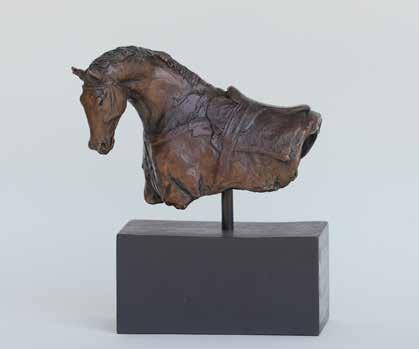








Grosser Dallmayr-Preis, Gr.1, Munich
Grosser Preis von Bayern, Gr.1, Munich
Sun Chariot Stakes, Gr.1, Newmarket
mare of the month stellarta
Stellarta’s two runners are doing Mum proud this summer.
Her second foal and first runner Rumstar has gone from a Group 3 -winning juvenile to a two-time Group 3-winning five-year-old, while his juvenile full-brother Amorim was a smart winner on his second career start and has picked up Listed-placed form in Newbury’s Rose Bowl Stakes. He is entered in York’s Group 2 Gimcrack Stakes
Stellar summer

Rumstar winning the Group 3 Palace House Stakes, the first of the Havana Grey gelding’s two Group race victories this season
mare of the month stellarta
RUMSTAR’S SUCCESS in the Coral Charge (G3) may not have been the headliner of Eclipse day, but his success was a timely reminder of the solid, hard-knocking families that, are the backbone of the racing industry, away from the blockbuster acts.
It was a fourth black-type success for the son of Havana Grey, whose pedigree draws not only on the meteoric success of his sire, but also the grit and talent of his female family.
Back in May 2022, Rumstar finished second on debut by a head, only two weeks after Star Of Lady M, his paternal half-sister and former paddock mate at Whitsbury Manor Stud, had opened their sire’s account.
He then got off the mark just over two weeks later when scoring at Bath and collected that first early black-type for Havana Grey when third in the Listed National Stakes a fortnight later.
The colt capped a busy season when landing the Cornwallis Stakes (G3) on his seventh run of the year. Gelded after a sub-par three-year-old season, Rumstar resumed winning ways late in his four-year-old season, winning the Listed Rous Stakes and is enjoying a great season at five – he collected the Palace House Stakes (G3) before his most recent success.
Stellarta celebrated a second winner on her record when Rumstar’s full-brother Amorim hacked up by 6l at Windsor on his second start in the colours of Sheikh Mohammed Obaid, a week prior to Rumstar’s latest win.
He went onto pick up Listed placed black-type in July’s Rose Bowl Stakes at Newbury, three years and two months after his full-brother collected that first Listed form in 2022.
The juvenile, in the care of George Boughey, has twice been an expensive sales horse – he was purchased for 250,000gns from the Whitsbury Manor Stud draft at the Tattersalls December Foal Sale by Rumstar Bloodstock, and then was snapped up by Boughey for a cool 500,000gns during the Tattersalls October Book 1 Sale when offered by Longview Stud.
Amorim’s escalating price tag undoubtedly owes more to the ever-growing legend of his sire than to the exploits of his hard-knocking brother.
But let us also not forget about the part played by their dam.
In so many ways, Stellarta typifies the kind of
Stellarta (GB)
Sakhee’s Secret-Torgau (Zieten) Bay mare 07.04.2011
2019: Adaay filly, died as a foal
2020: Rumstar (Havana Grey) G3 winner
2021: Barren to Due Diligence
2022: Sergei Prokofiev colt, died as a yearling
2023: Amorim (Havana Grey), maiden winner
2024: Missed to Havana Grey
2025: Colt by Havana Grey
doughty mare that Whitsbury Manor Stud both produces and manages to such a degree that they so often outstrip the bare bones of their pedigree page.
Bred by Whitsbury Manor Stud in partnership with Pigeon House Stud, Stellarta was purchased for just 5,000gns in Book 2 of the Tattersalls October Yearling Sale in 2012, with owner Vincent Ward signing the docket.
Trained by Michael Blanshard, she had repaid
In so many ways, Stellarta typifies the kind of doughty mare that Whitsbury Manor Stud both produces and manages to such a degree that they so often outstrip the bare bones of their pedigree page

Trainer Jonathan Portman (second left) and team with Rumstar after the Group 3 win at Sandown
mare of the month stellarta
Torgau made all to triumph by a length and a quarter in the Cherry Hinton Stakes (G2) and rounded off a triumphant season when twice runner-up in Group 1 company, first in the Moyglare Stud Stakes and then in the Cheveley Park Stakes by a head
that price tag – just – when she got off the mark in an auction maiden at Beverley in September, having been placed on each of her six previous starts, beginning in May. She won again at three, four and five, and raced until she was six, with long campaigns every season – 12 starts at four, 14 at five, and 14 when winless at six – for a total of seven victories and 16 places from 53 starts, none black-type.
When Stellarta returned to her birthplace for paddock duties, she quickly became a consort for the younger members of the Whitsbury Manor Stud roster, although she has been in a monogamous relationship with Havana Grey since 2022.
While Stellarta is two from two with her progeny of racing age, it is worth noting that she lost two of her foals and failed to get in foal on other occasions.
Stellarta’s racing record may be blue-collar, but her family gave plenty of hints at talent.
The most obvious highlight is her dam, the Zieten mare Torgau. Purchased by Paul and Sara Thorman’s Trickledown Stud for 13,000gns as a foal at Tattersalls, the filly made the same price as a yearling.
Trained by Giles Bravery, Torgau made a winning debut at Catterick in early June 1999 in the colours of the TT Partnership, and went on to finish sixth in the Queen Mary Stakes, then a Group 3, at Royal Ascot on her second start.
A few weeks later, Torgau made all to triumph by a length and a quarter in the Cherry Hinton Stakes (G2) and rounded off a triumphant season when twice runner-up in Group 1 company, first in the

Moyglare Stud Stakes and then in the Cheveley Park Stakes by a head.
Named European champion two-year-old at the 1999 Cartier Racing Awards, Torgau failed to train on at three, finishing seventh in the 1,000 Guineas on her sole start in Britain.
Once at stud, she produced only two other winners besides Stellarta, but several of her daughters have gone on to produce winners themselves.
Of those, perhaps the most noteworthy is Tevara, a daughter of former Whitsbury Manor inmate Compton Place, who has foaled the Prix de Ris-Orangis (G3) winner Ocean (Exosphere) and the dual Listed winner Aiming For Rio (Rio De La Plata).
Torgau was one of ten winners out of the juvenile winner Snoozy Time, a daughter of the Cavo Doro, who was runner-up to Morston in the 1973 Derby.
While Torgau was much the best of Snoozy Time’s progeny, she also produced Fujiyama Crest (Roi Danzig), who earned his place in the history books as the final leg of Frankie Dettori’s Magnificent Seven.
Further back in the family is Snoozy Time’s half-brother, the high-class sprinter Grey Desire (Habat), who won the Duke Of York Stakes (then G3), and was runner-up to Green Desert in the 1986 July Cup (G1).
Trained by Mel Brittain to win 13 of his 65 races, he retired to stand at Brittain’s Northgate Lodge Stud. While he never attracted large books, he did produce a number of winners in his second career.



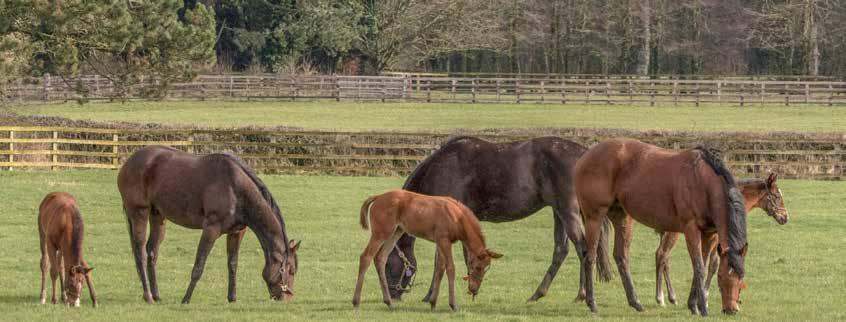
Working for Irish Breeders and Supporting Our Breeding Industry
MEMBERS’ BENEFITS INCLUDE
SUBSCRIPTION FEE:
F100 per annum
F50 add. family member
F20 ITBA Next Generation (U30)
SI GN UP TODAY!


Specifically designed Stud Farm Insurance exclusive to ITBA Members
FREE Racecourse Admission
FREE Diary and Calendar
FREE breeding and racing publications
inc digital subscriptions to EBN, The Owner Breeder, International Thoroughbred when a horse you bred is declared to run
Discount Racing TV Subscription
Discount packages with Irish Equine Centre Plus many more...
Greenhills, Kill, Co Kildare
www.itba.ie • Tel: 045 877 543 • office@itba.ie




Photos: (Main) Daniel O’Neill
photo finish: kicking out
HOTAZHELL gets the Irish champion trainer Aidan O’Brien get running – the son of Too Darn Hot taking a pot shot at O’Brien when he is let go to go to the start of the Group 1 Eclipse Stakes, jockey Sean Foley doing his best to steer the Jessica Harrington-trained three-year-old clear of injuring O’Brien.
In the end no damages was done - and O’Brien won the Eclipse for the ninth time, this year with Delacroix.
Hotazhell’s enthusiasm continued into the race, and after taking a keen hold, he faded to finish fifth in the six-strong field.









First yearlings 2025
GR.1
Prix du Moulin GR.1
Qatar Sussex Stakes

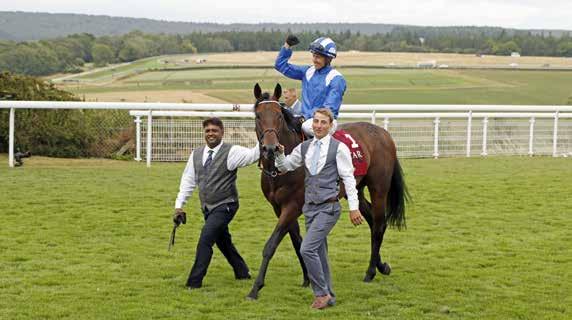
Al Shaqab Lockinge Stakes
GR.1
Queen Anne Stakes

Stands at Beech House Stud, UK
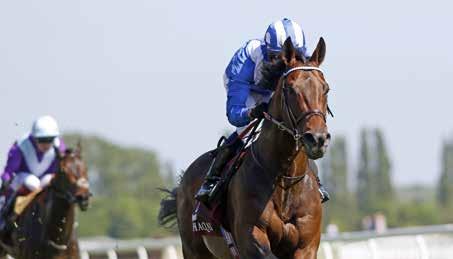
Juddmonte International Stakes GR.1
Queen Elizabeth II Stakes

To book a nomination or arrange a viewing contact Will Wright: +44 (0)7787 422901 | nominations@shadwellstud.co.uk View our stallion roster: www.shadwellstud.com
